How to allow pop-ups in Safari on iPhone, iPad and Mac
It seems like we put so much effort into blocking things like pop-ups and ads when we’re browsing the web that we forget about sites that actually use pop-ups for good reasons. It could be a shopping site where you get a confirmation, a CMS where you can use tools, or a social site where you log in.
In Safari on iPhone or iPad, you can allow pop-ups globally; and on Mac, you can even allow them just for the specific sites you want. Here’s how to do both.
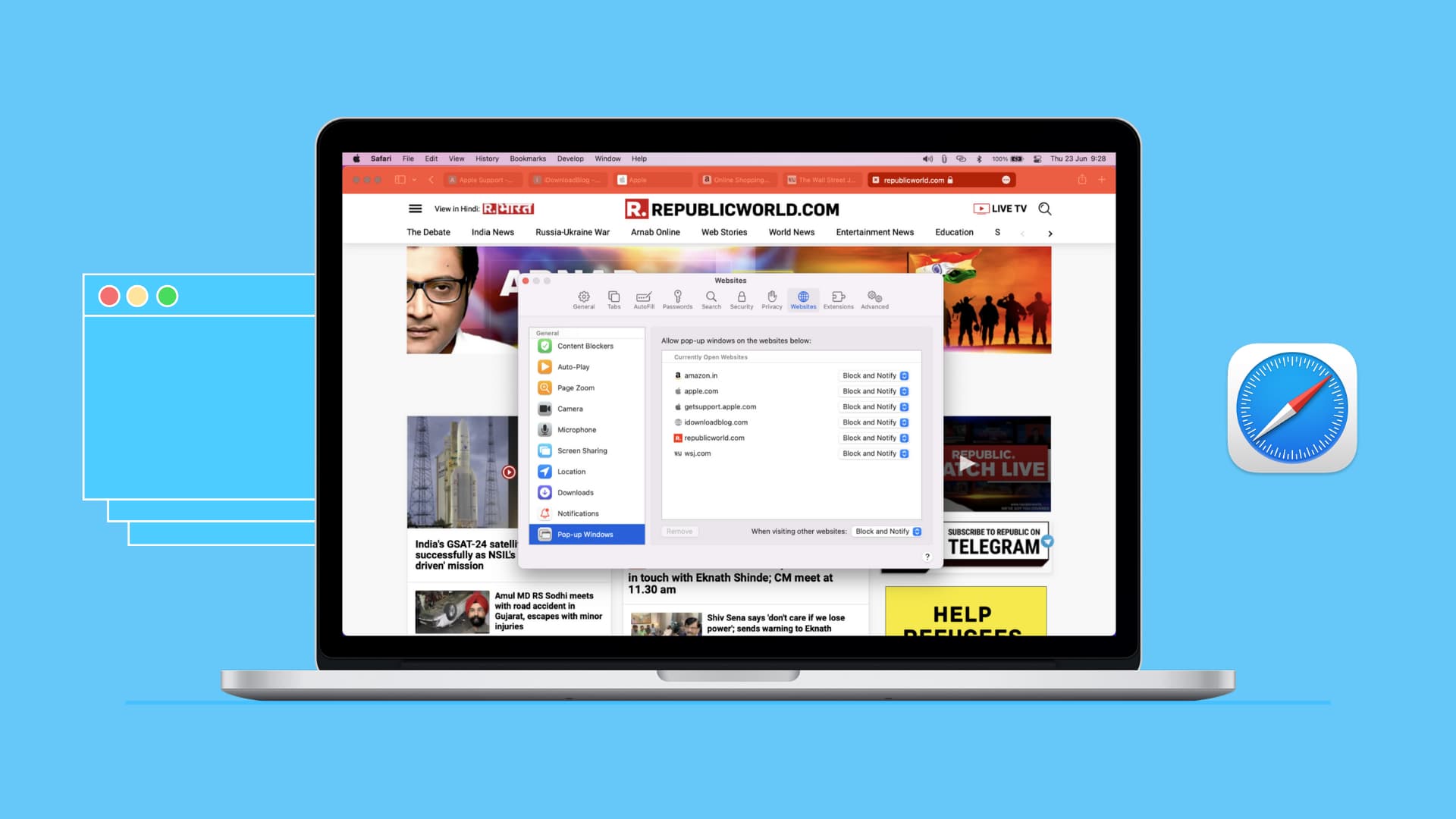

Allow pop-ups in Safari on iPhone and iPad
On iPhone and iPad, you cannot currently specify which sites you want to allow pop-ups for. It’s a global setting that you can enable or disable. The best option to allow pop-ups for a particular site is to turn off the setting, visit the website you want to see the pop-ups for, and then turn the setting back on.
Open Settings and select Safari . Turn off the toggle for Block Pop-ups .

When you finish visiting the site whose pop-ups you want to see, you should strongly consider turning the Block Pop-ups setting back on. Otherwise, you could end up inundated with ads or even unsafe pop-ups on your device.
Related: How to increase privacy in Safari on iPhone and iPad
Allow pop-ups in Safari on Mac
You have a couple of ways to allow pop-ups in Safari on Mac for the sites you trust. You can do this in the Preferences or with the site active in Safari. By taking a few moments to configure certain sites, you’ll save some aggravation later, waiting for that pop-up that never comes.
Allow when on the website
Suppose you clicked a link that triggered a new pop-up window. But if you have restricted pop-up windows in Preferences, the pop-up window won’t open and display a message temporarily in the Safari address bar. Besides that, it will show a tiny pop-up icon . Simply click that icon in the address bar, and it will open the blocked pop-up window.

When starting a live chat with Apple Support or downloading booked train tickets, I always use this method to allow the website to open the requested pop-up window.
Allow pop-ups in Preferences
- Open Safari and click Safari > Preferences from the menu bar.
- Select the Websites tab.
- On the left, scroll down to and pick Pop-Up Windows .
- To the right, you have your Currently Open Websites at the top with any Configured Websites at the bottom. Next to each, select the drop-down box and pick Allow for those you want to allow pop-ups.
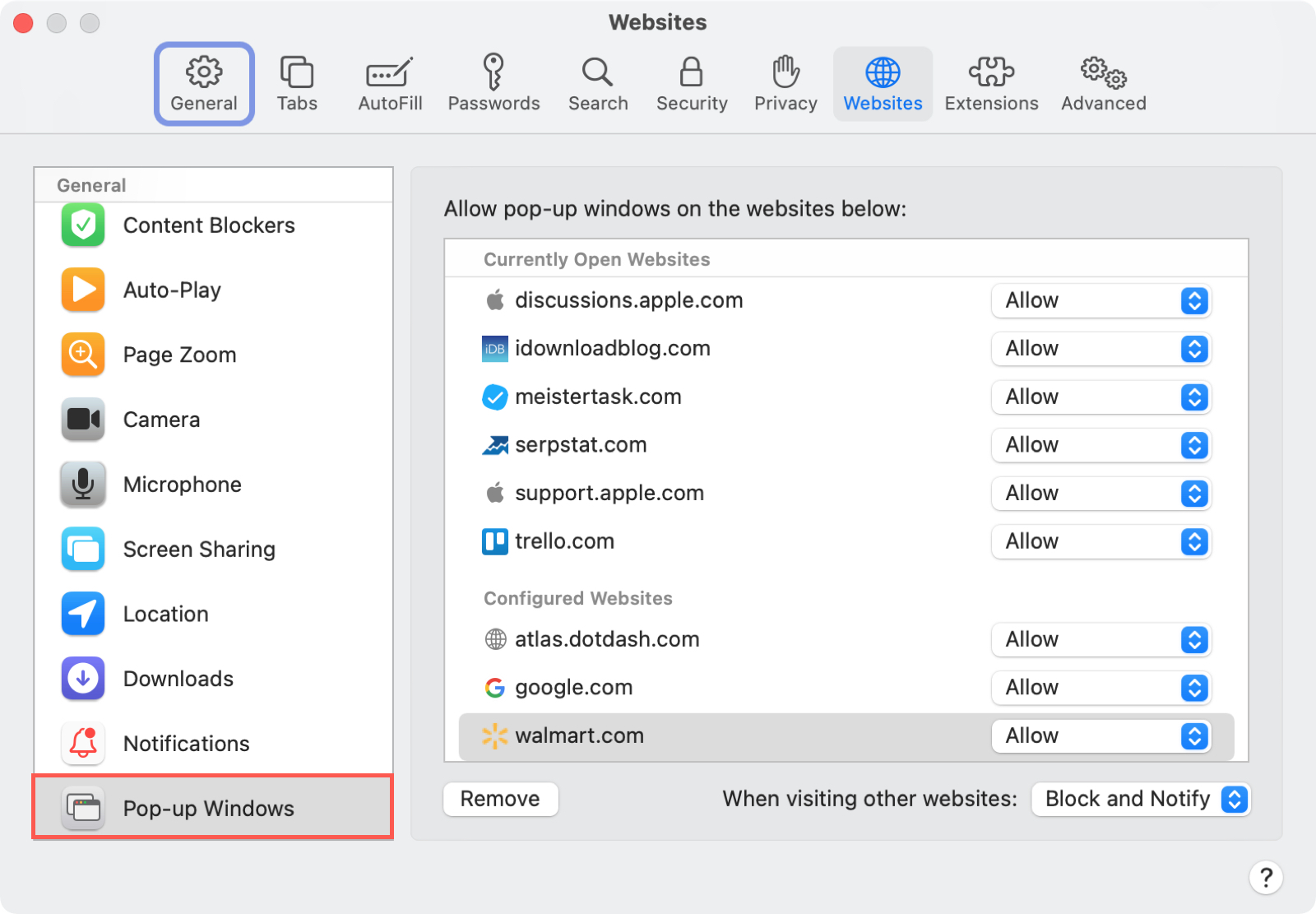
For any sites that you don’t want to allow or that you want to be notified, select either Block or Block and Notify in that drop-down box.
At the bottom, next to When visiting other websites , you have a drop-down box with those three options as well. This is a global setting that covers all other sites you visit that you have not yet configured.
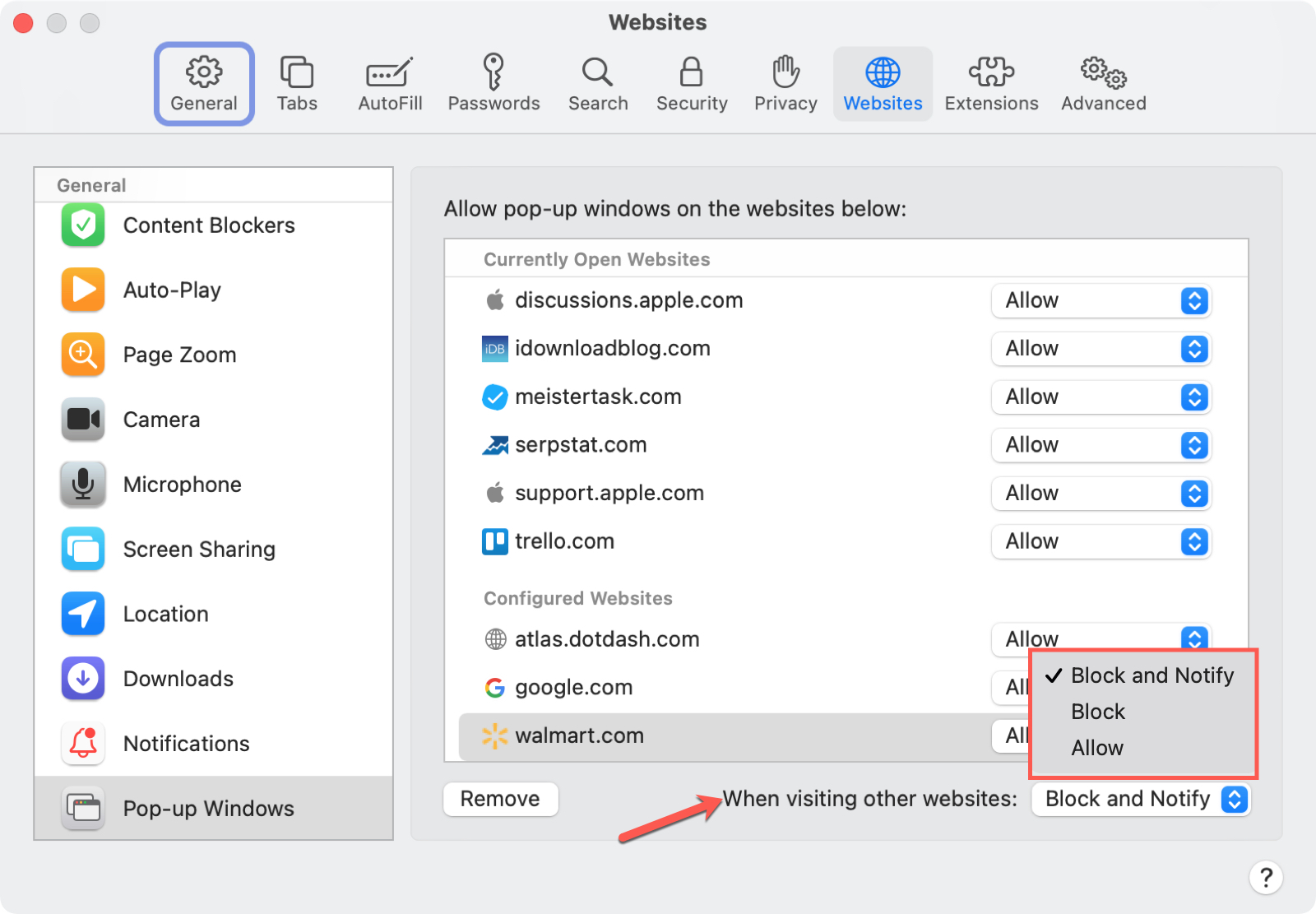
Allow pop-ups in the Safari window
- Right-click the address bar for the site you’re viewing and select Settings for site name or Settings For This Website .
- In the small window that appears, go down to Pop-up Windows .
- Use the drop-down box to choose Allow to see pop-ups for that website. Obviously, you can choose Block or Block and Notify for those you don’t want to see pop-ups.
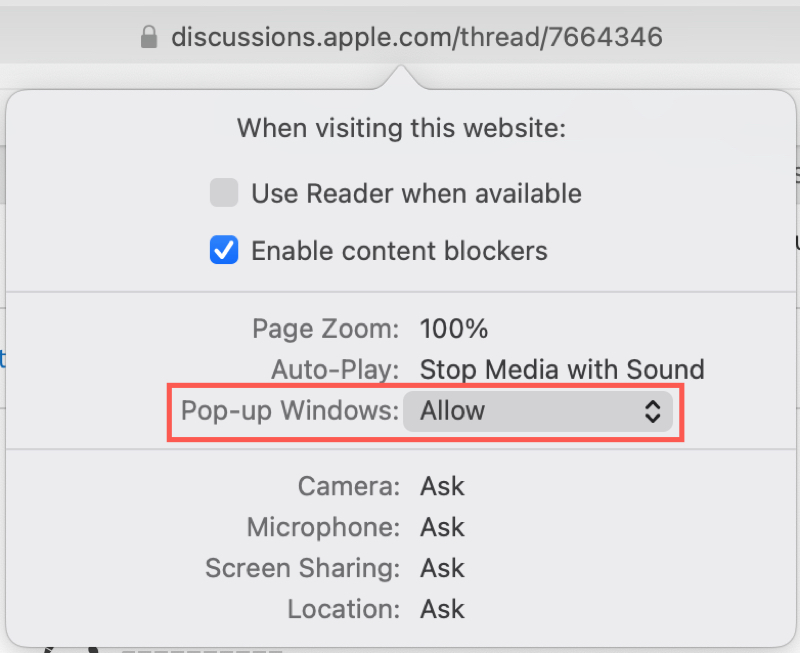
When you use this method to adjust pop-ups for particular websites, these sites will then be added to the Configured Websites list in your Preferences, as explained above.
Hopefully, Apple will offer the ability to configure pop-ups for specific sites in Safari on iPhone and iPad at some point, just like on Mac. But in the meantime, you do have a way to allow pop-ups for the sites you want on all your devices.
Which types of websites do you want or need to see pop-ups for? And will you take the time to make sure you can? Let us know!
More Safari tips:
- How to open multiple websites at once on Mac
- 11 tips to customize and personalize Safari on iPhone and iPad
- How to stop name, address, email, and payment autofill suggestions in Safari
- How to safely install and use Safari extensions on iPhone
Easily Block or Allow Pop-Ups in Safari on iPhone
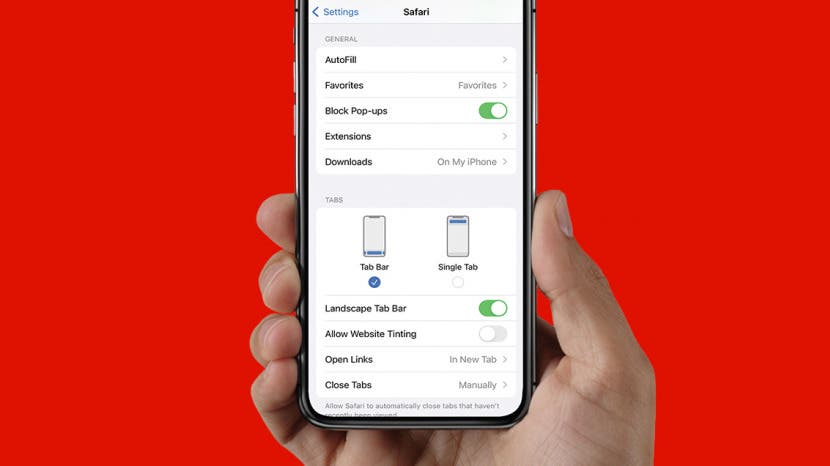
Is the pop-up blocker for Safari stopping pop-ups you actually need? Conversely, if you've been having trouble with pop-ups on your iPhone whenever you try to browse online, you're probably hoping for a way to block pop-ups on Safari. In this tip, we'll show you how to do both. Let's go over how to use the pop-up blocker on iPhone.
Why You'll Love This Tip:
- Temporarily disable your pop-up blocker if a website relies on them to function.
- Block intrusive pop-ups if you are having trouble browsing the web.
How to Turn Off the Pop-Up Blocker on iPhone
System requirements.
This tip works on iPhones running iOS 16 or later. Find out how to update to the latest version of iOS .
The Safari pop-up blocker on iPhone is turned on by default, meaning that pop-ups will be blocked in Safari unless you turn your pop-up blocker off. Note that this article doesn't cover how to disable in-app rating pop-ups on the iPhone; you will need to do that in the App Store settings. If you're looking to learn more about browsing settings on your iPhone or other devices, our free Tip of the Day newsletter can help. If you find that pop-ups you actually want are being blocked, you can simply allow pop-ups in Safari while you browse that site and then switch it back on! Here's how to allow pop-ups on iPhone:

That's how to disable the pop-up blocker on iPhone. For one of Apple's simpler settings, it can make quite a difference in your experience while browsing on Safari. If you want to turn your pop-up blocker back on, you can follow the same steps above. Have you ever come across an image you loved on Safari, but were unsure how to save it properly? If so, you might want to learn these two easy ways to save images from Safari on your iPhone.
Author Details

Rich Hall has written about Handheld and Pocket computers for the last 13 years. He is the Editor of Pocket PC magazine and former editor of The HP Palmtop Paper, the NEC Ultralite Connection and the HP Portable Paper. He began his career as a high school Math and English teacher. Rich lives in Fairfield, Iowa, with his wife, Lucinda, and their children, Robert and Ella. You can contact him at [email protected] .

Article Spotlight
Matias is launching a brand new keyboard based on a classic design.

The Matias Sculpted Ergonomic Keyboard improves on the legacy of the beloved Microsoft Sculpt Keyboard with upgrades that make it more functional and comfortable than ever before! The Matias Sculpted Ergonomic Keyboard stays true to the spirit of the discontinued Microsoft original.
Featured Products
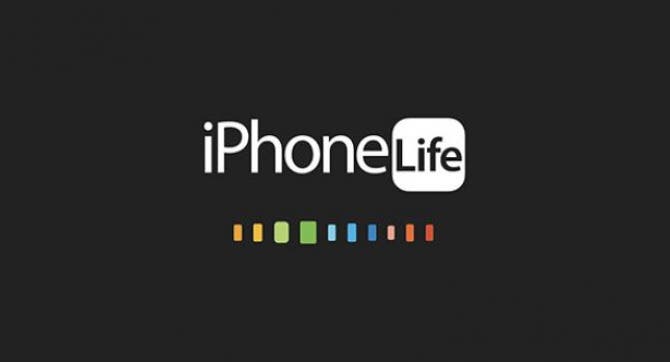
In episode 211, David and Donna cover Apple's "Let Loose" event that went live on May 7th, 2024. This event was all about the new supercharged iPads. From the AI-focused M4 chip to inky-black OLED, tune in to find out if it really is the biggest iPad update since its original release! Listen now and find out !
Most Popular

How to Tell If Someone Blocked Your Number on iPhone
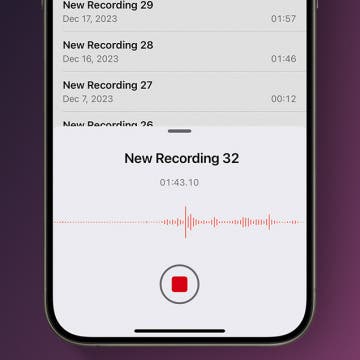
How to Record a Phone Call on an iPhone for Free

How to Tell If a Dead iPhone Is Charging

How to Schedule a Text Message on iPhone

10 Simple Tips To Fix iPhone Battery Drain

How To Put Two Pictures Together on iPhone

How To Find My iPhone From Another iPhone

How to Adjust Exposure in the iPhone Camera App

Can iPhones Get Viruses? How to Detect & Remove Malware (iOS 17)

iPhone Notes Disappeared? Recover the App & Lost Notes

How To Get an App Back on Your Home Screen
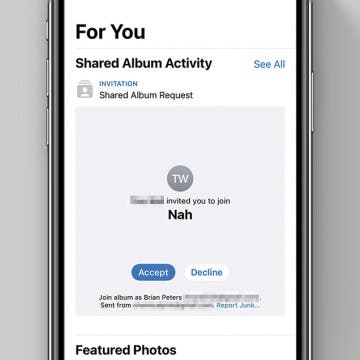
How to Accept a Shared Album Invite on Your iPhone
Featured articles, why is my iphone battery draining so fast 13 easy fixes.

Identify Mystery Numbers: How to Find No Caller ID on iPhone

Apple ID Not Active? Here’s the Fix!

How to Cast Apple TV to Chromecast for Easy Viewing

Fix Photos Not Uploading to iCloud Once & for All (iOS 17)

There Was an Error Connecting to the Apple ID Server: Fixed

CarPlay Not Working? 4 Ways to Fix Apple CarPlay Today
Check out our sponsors.

- Each email reveals new things you can do with your phone (and other devices) with easy-to-follow screenshots.
- Enter your email to get your first tip immediately!
How to block pop-ups on Safari for iOS and iPadOS
Here's how to block pop-ups on Safari's mobile and tablet app

It's important you learn how to block pop-ups on Safari when you're using the iPhone or iPad version of the browser. Despite being some of the best phones and best tablets around, iPhones and iPads are not immune to pop-ups.
As you may already know, pop-ups are a menace. Not only do they get in the way of the content you're trying to read or watch, they can also present security concerns, directing you to nefarious websites. Needless to say, then, blocking them is pretty much a necessity.
But how do you block pop-ups on your iPhone? You'd be forgiven for thinking you have to sign up for or purchase one of the best ad blockers . But although those are great, luckily, you don't need them — your iPhone comes pre-loaded with a Safari pop-up blocker. All you need to do is make sure it's turned on, and this guide is here to show you how.
Read on to see how to block pop-ups on Safari for iOS and iPadOS.
1. Open the Settings app , then scroll down and tap Safari .

2. Toggle on Block Pop-ups .
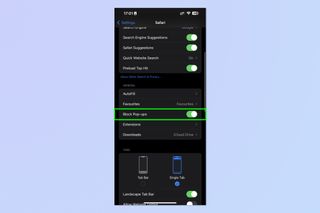
That's really all there is to it. Safari will now block pop-ups for you, meaning you don't have to think about them again. Unfortunately, there's no option for blocking ads too, but we've got a guide on how to block ads on iPhone using Opera browser which, if you haven't already tried it, may tempt you away from using Safari for good thanks to free a built-in ad blocker, pop-up blocker and other cool features.
Sign up to get the BEST of Tom’s Guide direct to your inbox.
Upgrade your life with a daily dose of the biggest tech news, lifestyle hacks and our curated analysis. Be the first to know about cutting-edge gadgets and the hottest deals.
If you'd like to read more iPhone guides, we've got you covered with our range of tutorials. Just got a new iPhone? Learn how to transfer data from iPhone to iPhone and get everything transferred over smoothly. Is your iPhone being a little sluggish? Find out how to clear RAM on iPhone , as this can usually help speed things up. You may also want to check out how to hard reset an iPhone , which could also help kick your iPhone back into gear. Dropped your iPhone in water? Learn how to eject water from an iPhone . Got a load of Live Photos? Here's how to turn Live Photos into video on iPhone . Want to end your TikTok addiction? Here's how to set time limits on iPhone apps with Screen Time . Going skiing? Learn how to disable Crash Detection on iPhone so your phone doesn't call the ambulance when it shouldn't.

Peter is Reviews Editor at Tom's Guide. As a writer, he covers topics including tech, photography, gaming, hardware, motoring and food & drink. Outside of work, he's an avid photographer, specialising in architectural and portrait photography. When he's not snapping away on his beloved Fujifilm camera, he can usually be found telling everyone about his greyhounds, riding his motorcycle, squeezing as many FPS as possible out of PC games, and perfecting his espresso shots.
Apple iPhone 16 Pro tipped to get this major display upgrade
Apple is reportedly planning iPhone 17 Slim — but I want this instead
Lomachenko vs Kambosos Jr live stream: How to watch boxing online, fight card, start time, odds
Most Popular
- 2 Apple iPhone 16 Pro tipped to get this major display upgrade
- 3 Apple could unveil revamped Siri with generative AI at WWDC — here’s the key upgrades
- 4 Plush queen mattress vs firm queen mattress: Which is best for your budget and sleep?
- 5 How to watch Google I/O 2024: Android 15, Gemini and more

We explain and teach technology, solve tech problems and help you make gadget buying decisions.
How to Allow Pop-Ups in Safari for iPhone, iPad, and Mac
Parth Shah is an evergreen freelance writer covering how-tos, app guides, comparisons, listicles, and troubleshooting guides on Android, iOS, Windows, Mac, and smart TV platforms. He has over five years of experience and has covered 1,500+ articles on GuidingTech and Android Police. In his free time, you will see him binge-watching Netflix shows, reading books, and traveling.
The Safari browser on Apple devices delivers fast performance and excellent security features. It blocks harmful pop-ups by default and offers a private browsing experience with a Private Relay add-on. But sometimes, you may need to enable pop-ups for a specific website to check the content. Whether it’s a banking website or a university login page, the website might ask you to enable pop-ups temporarily.

Most websites throw unwanted ads via pop-ups. It’s one of the reasons why Safari blocks pop-ups by default on iPhone, iPad, and Mac. But, you’ll need to allow pop-ups for banks and other important websites. For example, when you try to download a monthly statement from your bank’s website, it may open the document in a pop-up. Luckily, Safari let’s you enable pop-ups for such exceptions and here’s how you can do that on iPhone, iPad, and Mac.
Allow Pop-Ups in Safari for iPhone and iPad
You can allow pop-ups for all websites in Safari for iPhone and iPad. Unlike the Safari macOS version, there is no way to allow pop-ups for specific websites. Follow the steps below to make changes.
Step 1: Open the Settings app on your iPhone and scroll to Safari.
Step 2: Disable the Block Pop-ups toggle.
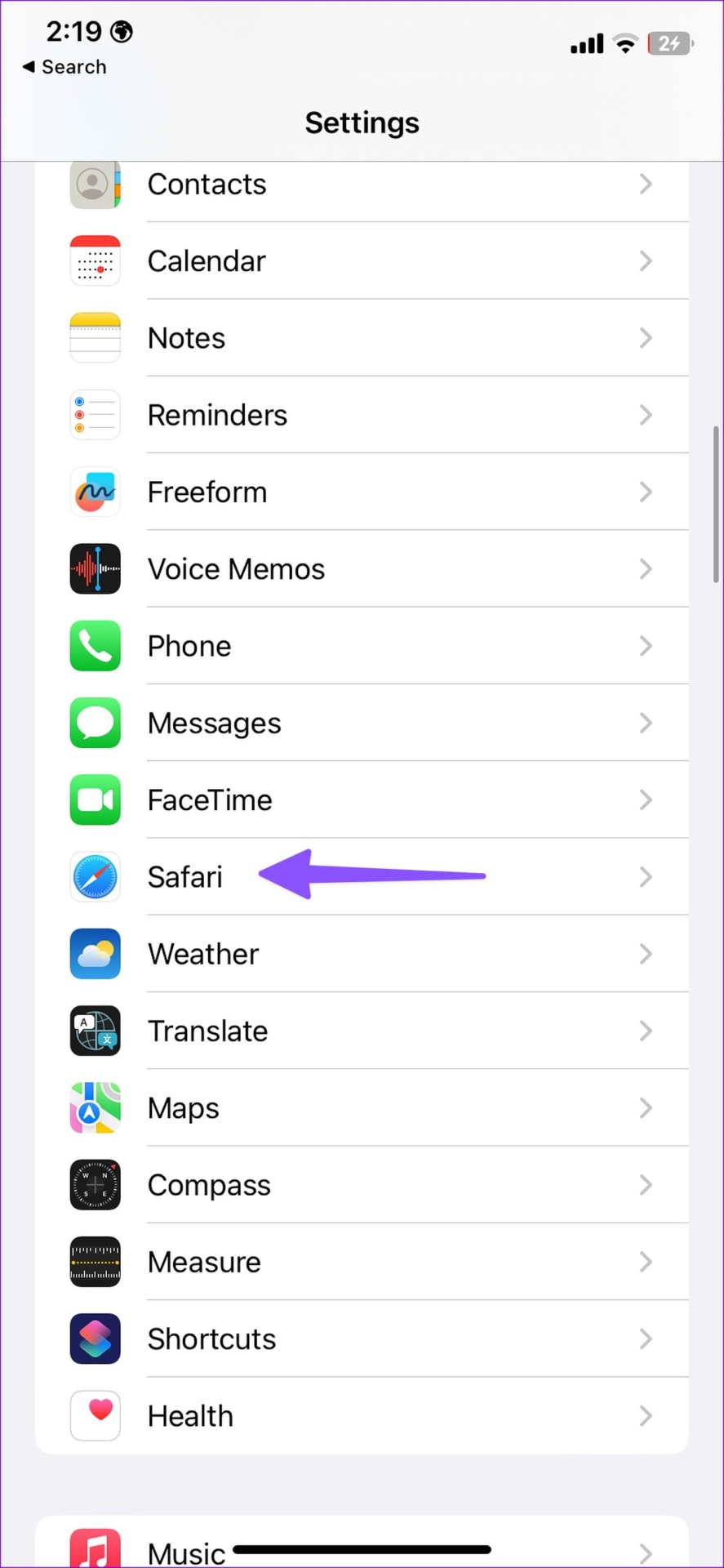
Allow Pop-Ups for All Websites in Safari for Mac
Safari on macOS offers better control over pop-ups. You have the option to enable pop-ups for all websites or specific ones. Here’s what you need to do.
Step 1: Open Safari on your Mac. Click Safari menu at the top-left corner on the menu bar.
Step 2: Select Settings from the context menu.
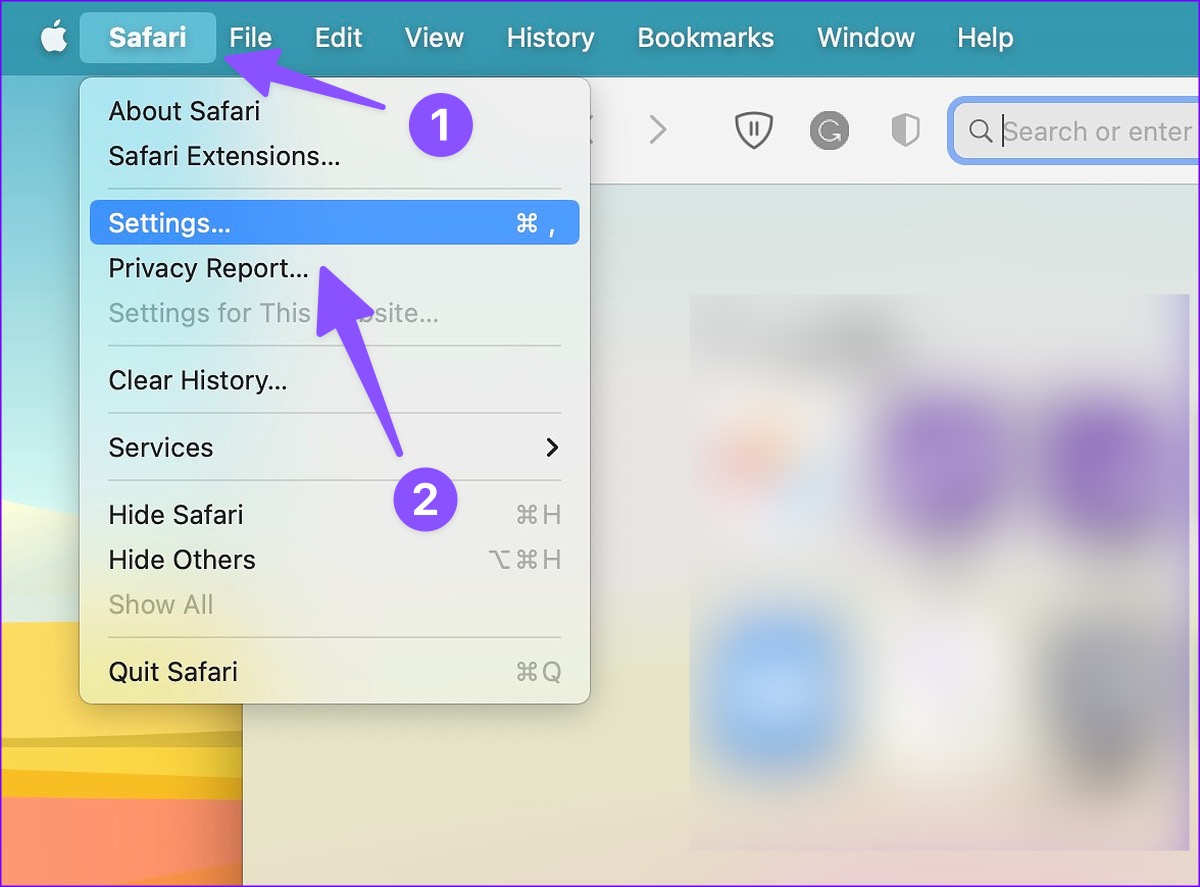
Step 3: Click on the Websites tab at the top and select Pop-up Windows from the left sidebar.
Step 4: Open the menu beside ‘When visiting other websites.’
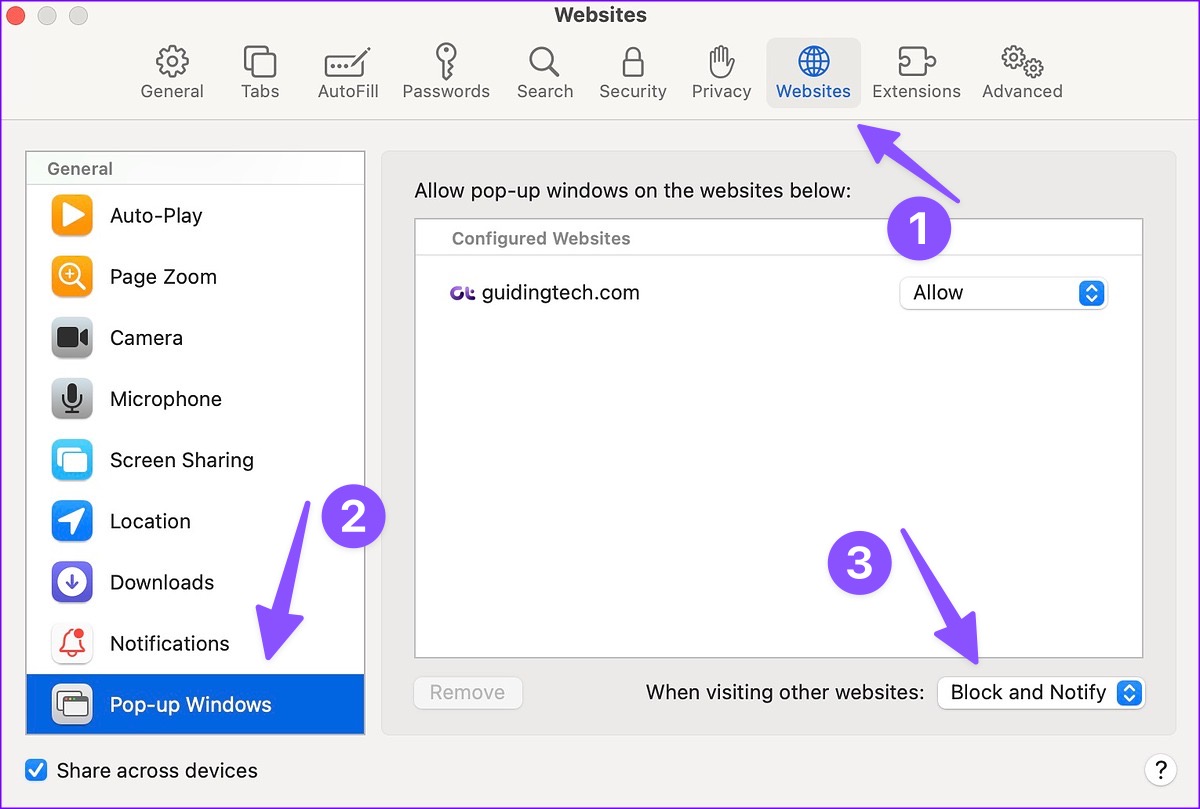
Step 5: You have three options to choose from.
Block and Notify: It’s the default option and blocks pop-ups on all websites. Safari also notifies you when it blocks pop-ups.
Block: It will simply block pop-ups on all websites in the background and won’t notify you about it. We don’t recommend using this option as you may miss important information
Allow: As the name suggests, the option allows pop-ups on all websites.
Step 6: Select Allow.
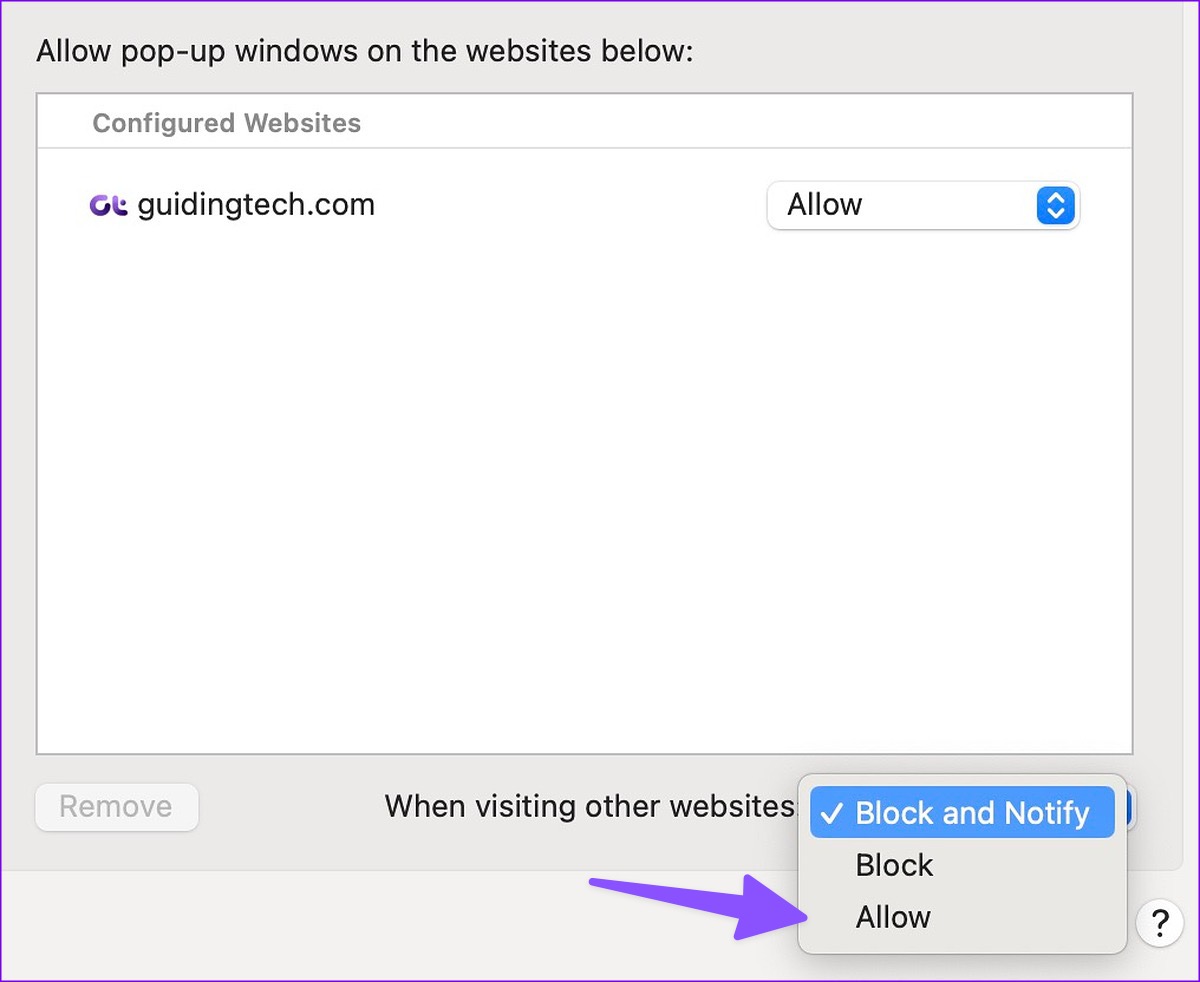
You’ll need to be careful when you allow pop-ups for all websites. You may end up seeing unnecessary pop-ups on harmful websites. Thankfully, there is an option to allow pop-ups for specific websites only.
Allow Safari Pop-Ups for Selected Websites on Mac
You don’t need to head to Safari settings to allow pop-ups for a specific website. Once Safari notifies you of blocking a pop-up, allow permission from the address bar only.
Step 1: Open Safari on your Mac.
Step 2: Visit a website. If you see Safari blocking a pop-up, right-click (or two-finger click on the Mac trackpad) on the address bar at the top.

Step 3: Open the ‘Settings for a website’ option.
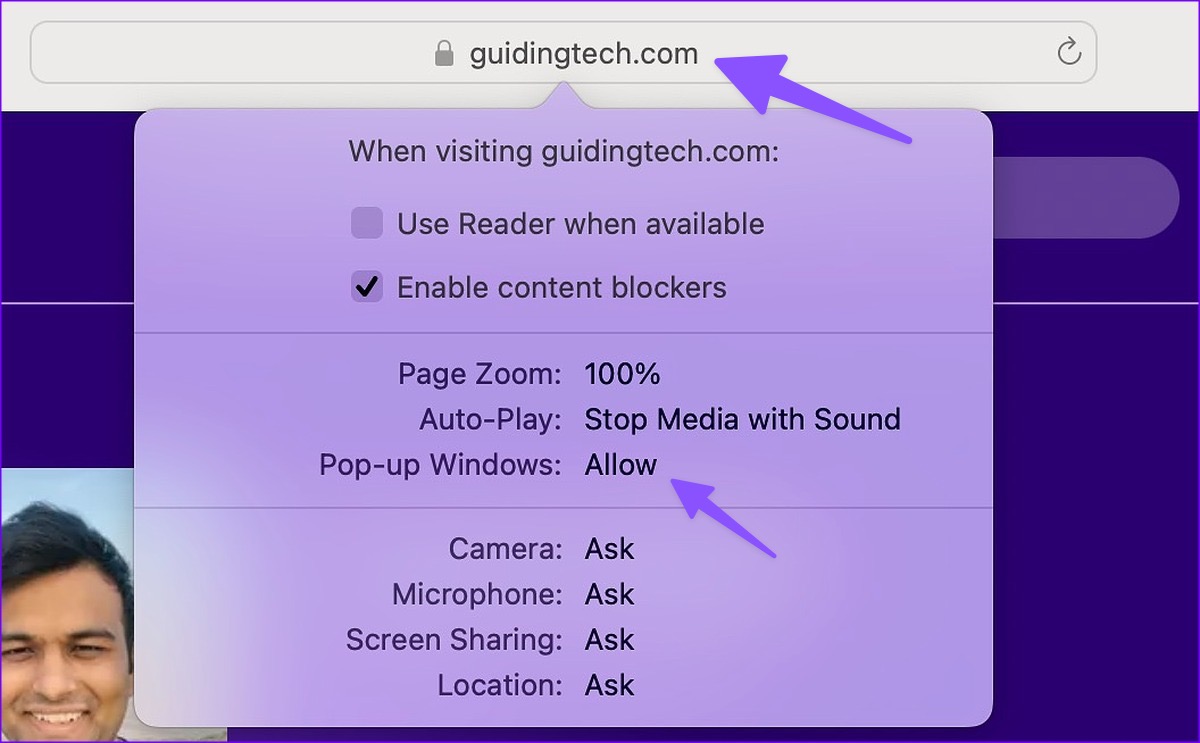
Step 4: Expand the Pop-up widows and select Allow.
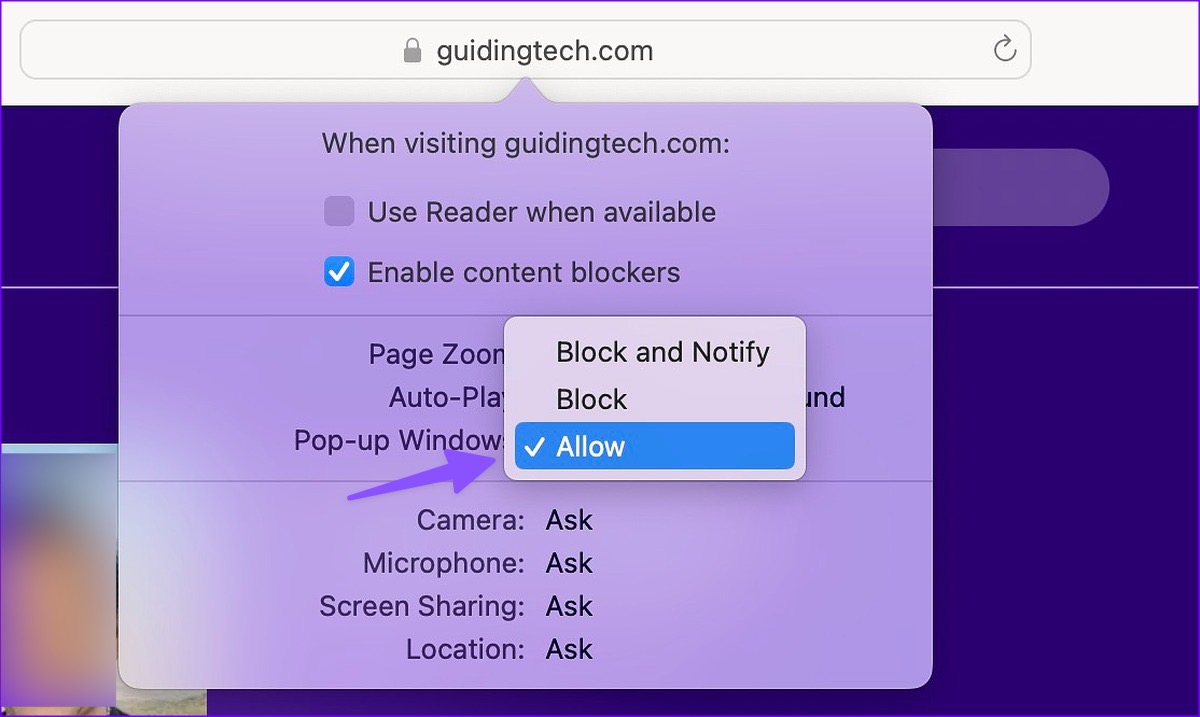
You can also hit the Safari option in the menu bar and open Settings for a website.
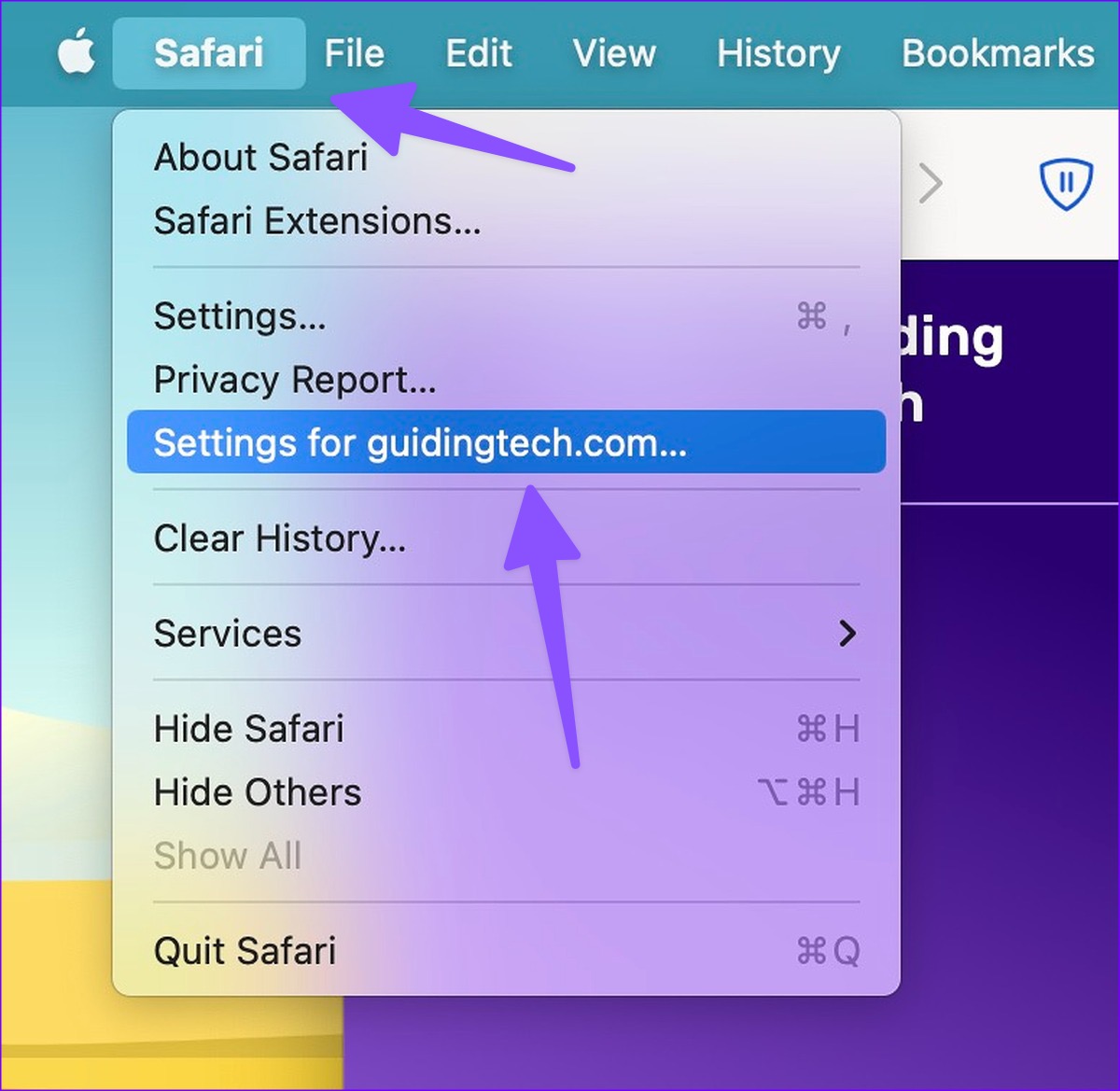
Manage Pop-up Permission for Websites in Safari
If you have allowed pop-up permission for several websites in Safari for Mac, you may get a below-average web-browsing experience . You can check which websites have pop-up permission and disable it for irrelevant ones. Here’s how.
Step 1: Click on the Safari menu at the top-left corner on the menu bar. Select Settings from the context menu.
Step 2: Select the Websites menu.
Step 3: Check which websites have permission to show pop-ups.
Step 4: Click the website and hit Remove to disable the permission. You can also open the side menu and select Block.
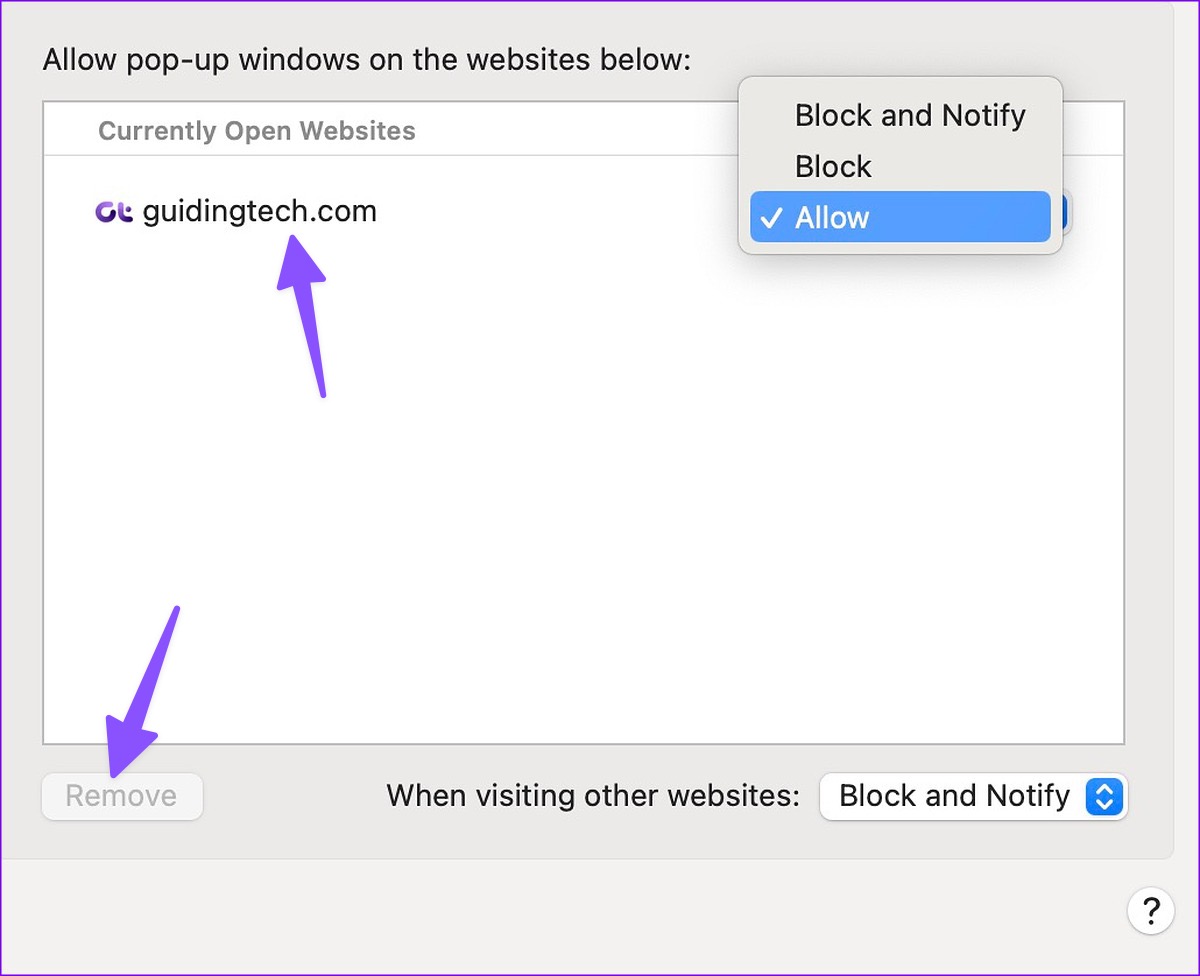
How Do I Know Which Pop-Ups to Block in Safari?
You’ll need to only allow pop-ups for websites you trust. You can enable pop-ups for banks, stock trading, and other frequently visited websites. If you encounter unfamiliar questionable websites during web browsing, block pop-ups on them.
Are Safari Pop-Ups Harmful?
It depends on the type of website you are visiting on Safari. If it’s a spammy content website or a streaming service with unlicensed content, they may send an unbearable number of pop-ups to trick you into clicking on them. Such unintentional and accidental clicks may show irrelevant ads and download unverified programs on your Mac. That’s why we recommend enabling pop-up permission for selected trusted sources only.
Customize Your Safari Experience
Allowing pop-ups in Safari is a double-edged sword. If you allow pop-ups for all websites, you may end up with unnecessary ads. Did you enable pop-ups for all websites or selected ones? Share your preference in the comments below.
Was this helpful?
Last updated on 13 March, 2023
The above article may contain affiliate links which help support Guiding Tech. However, it does not affect our editorial integrity. The content remains unbiased and authentic.
Leave a Reply Cancel reply
Your email address will not be published. Required fields are marked *
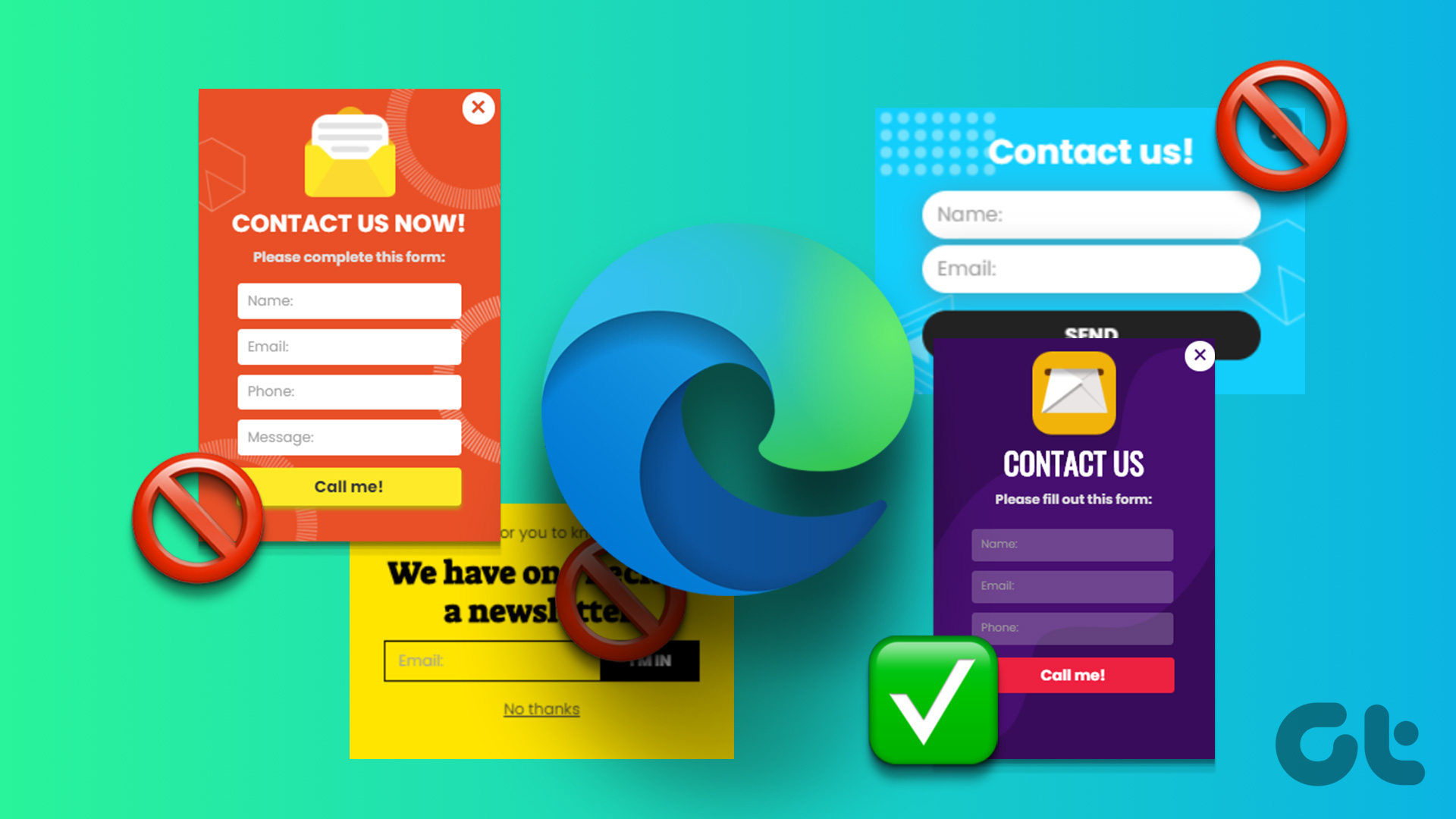
The article above may contain affiliate links which help support Guiding Tech. The content remains unbiased and authentic and will never affect our editorial integrity.
DID YOU KNOW
More in Mac

How to Download HEIC as JPG in iCloud on Windows and Mac
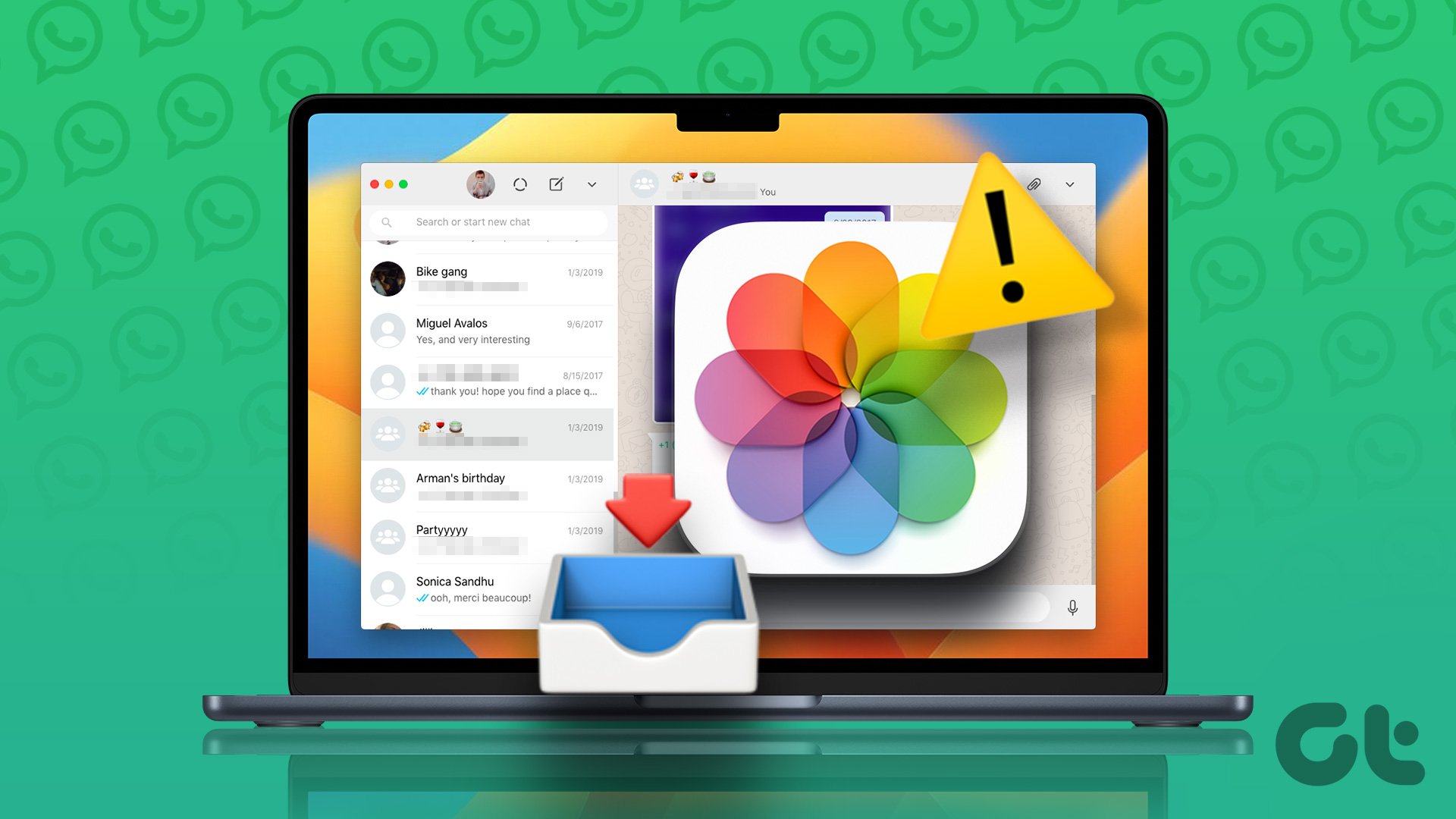
5 Fixes for WhatsApp Desktop Not Downloading Images
Join the newsletter.
Get Guiding Tech articles delivered to your inbox.
iOS 17 Guide: How to Allow Pop-Ups on iPhone
To allow pop-ups on your iPhone running iOS 17, simply head to the Settings app, select Safari, and toggle off the ‘Block Pop-ups’ option. By following these steps, you’ll soon be able to access all the pop-up content your heart desires.
After completing this action, any website you visit using Safari will be able to display pop-up windows. This could be particularly useful for certain sites that use pop-ups for login authentication, important notifications, or additional information without navigating away from the page you’re on.
You can also watch this video about how to allow pop-ups on iPhone for additional info.
Introduction
Pop-ups have a bit of a reputation, don’t they? Often seen as an annoyance or a sign of a potential security threat, pop-up windows have been blocked by default on many browsers, including Safari on the iPhone. But what if you need to enable them? Maybe there’s an essential form to fill out, or a crucial piece of information is hiding behind that blocked window. Whatever the reason, knowing how to allow pop-ups on your iPhone can be quite beneficial.
iOS 17, the latest version of Apple’s operating system for iPhones, has continued the tradition of blocking pop-ups as a default setting. However, there are legitimate reasons you might want to disable this feature. Whether you’re a student needing access to educational resources, a professional working with web-based tools, or just someone trying to redeem an online coupon, understanding how to manage pop-ups on your iPhone is an essential skill. So let’s dive into the world of Safari settings and pop-ups, shall we? By the end of this article, you’ll be a pro at handling them.
A Step-by-Step Tutorial on Allowing Pop-Ups on iPhone
Before we get into the nitty-gritty, let’s understand what we’re aiming for. Enabling pop-ups on your iPhone allows websites to display additional windows, whether for advertisements, special offers, or necessary functionality. Here’s how you do it.
Step 1: Open the Settings app
Navigate to your home screen and tap on the Settings app icon.
The Settings app is your gateway to customizing your iPhone experience. Here, you’ll find all the options to tweak your device’s behavior to your liking.
Step 2: Scroll down and select Safari
Swipe down until you find the Safari settings and tap on it.
Safari is the default web browser for iOS devices. It is optimized for Apple products and provides a smooth internet browsing experience.
Step 3: Find the ‘Block Pop-ups’ option
In the Safari settings, look for the ‘Block Pop-ups’ toggle.
This option is what’s preventing those additional windows from appearing when you’re browsing the web.
Step 4: Toggle off ‘Block Pop-ups’
Switch the ‘Block Pop-ups’ toggle to the off position (it should not be green).
By turning this off, you’re telling your iPhone that it’s okay for websites to show pop-up windows.
Additional Information
When it comes to iPhones and the internet, there’s always more to learn. Allowing pop-ups on iOS 17 is a simple change but can make a significant difference in how you interact with websites. There’s a balance to strike between security and convenience, and managing your pop-up settings is part of that.
Remember that while enabling pop-ups can be helpful, it’s also important to be cautious. Not all pop-ups have your best interests at heart. So, use this newfound power wisely, and don’t hesitate to toggle the ‘Block Pop-ups’ option back on for sites that you don’t trust. Additionally, consider using content blockers or security apps to add an extra layer of protection while browsing.
Finally, keep in mind that these settings are specific to Safari. If you use a different browser on your iPhone, such as Chrome or Firefox, you’ll need to adjust the pop-up settings within those apps separately.
- Open the Settings app
- Select Safari
- Find the ‘Block Pop-ups’ option
- Toggle off ‘Block Pop-ups’
Frequently Asked Questions
What are pop-ups.
Pop-ups are additional windows or tabs that open automatically on your web browser, often without your permission.
Are all pop-ups bad?
No, not all pop-ups are bad. Some are used for essential website functions, like logging in or displaying important information.
Can I enable pop-ups for specific sites only?
Yes, you can manage permissions for specific websites in your Safari settings under ‘Websites’ > ‘Pop-up Windows’.
Will allowing pop-ups affect my iPhone’s performance?
Generally, allowing pop-ups should not significantly affect your iPhone’s performance. However, too many pop-up windows could potentially slow down your browsing experience.
How can I prevent malicious pop-ups?
You can use content blockers or security software to help prevent malicious pop-ups, even when the ‘Block Pop-ups’ option is turned off.
All in all, learning how to allow pop-ups on iPhone with iOS 17 is a breeze. Whether you’re a tech newbie or a seasoned pro, adjusting your pop-up settings is just a few taps away. Remember to use this feature judiciously, keeping in mind both the potential benefits and risks. Stay informed, stay safe, and happy browsing!

Matthew Burleigh has been writing tech tutorials since 2008. His writing has appeared on dozens of different websites and been read over 50 million times.
After receiving his Bachelor’s and Master’s degrees in Computer Science he spent several years working in IT management for small businesses. However, he now works full time writing content online and creating websites.
His main writing topics include iPhones, Microsoft Office, Google Apps, Android, and Photoshop, but he has also written about many other tech topics as well.
Read his full bio here.
Share this:
Join our free newsletter.
Featured guides and deals
You may opt out at any time. Read our Privacy Policy
Related posts:
- How Do I Change Pop Up Blocker iPhone Settings in Chrome?
- How to Allow Pop Ups on iPhone 15: A Step-by-Step Guide
- Can I Disable the Pop-Up Blocker in Safari On My iPhone?
- iOS 17: How to Turn Off Pop-Up Blocker on iPhone – A Step-by-Step Guide
- iOS 17: How to Block Pop-Ups in Chrome on iPhone
- 15 Ways to Fix Safari Not Working on iPhone in 2023
- How to Allow Pop Ups in Safari on an iPhone 7
- Safari History iPhone: How to See It [2023 Guide]
- How to Turn Off Pop-Up Blocker in Firefox on iPhone: A Guide
- How to Disable the Pop Up Blocker in Internet Explorer 11
- How to Turn Off Pop-Up Blocker in Chrome on iPhone: A Guide
- How to Allow Pop Ups on iPhone 14
- How to Stop Pop Up Screens When iPhone Is Connected: A Step-by-Step Guide
- Why Can’t I Create a Private Browsing Tab in Safari on My iPhone?
- How to Get Safari Back on iPhone 13
- How to Block Pop-Ups on the iPad 2
- How to Block Pop-Ups in the Safari iPhone 5 App
- 15 iPhone Settings You Might Want to Change
- How to Do Private Browsing on iPhone 15: A Step-by-Step Guide
- How to Allow Pop Ups in Firefox – Windows 7
- Alexa vs. Google Assistant
- Amazon Prime Tech Deals!
How to Enable the Safari Pop-up Blocker
Block pop-ups on Mac, Windows, and iOS
:max_bytes(150000):strip_icc():format(webp)/ScottOrgera-f7aca23cc84a4ea9a3f9e2ebd93bd690.jpg)
What to Know
- To enable the pop-up blocker, go to Safari > Preferences > Websites > Pop-up Windows > choose how to handle pop-ups.
- To block pop-ups on iOS, go to Settings > Safari > General > Block Pop-ups .
- Another way to enable or disable pop-up blocker in Safari, select Preferences > Security > Block pop-up windows .
This article explains how to enable or disable the pop-up blocker within Safari. Instructions apply to macOS, iOS, and Windows.
You might need to disable the pop-up blocker for access to some sites. Alternatively, install plug-ins that suppress tracking and pop-ups for individual sites and browsing sessions.
The pop-up blocker for Mac computers is accessible through the Web content section of Safari's settings.
From the menu along the top of the Safari window, choose Safari > Preferences .
The keyboard shortcut to Safari's Preferences page is Command+, .
Select Websites .
Click Pop-up Windows .
Select the desired action for the current website. Block and Notify blocks pop-ups on the site and notifies you when it happens. Block blocks pop-ups without notifying you. Allow allows pop-ups.
To do the same when visiting other websites, select When visiting other websites in the lower-right corner of the window. If this checkbox is selected, Safari's integrated pop-up blocker is enabled.
In older OS X versions, select Windows > Preferences , then check the Block pop-up windows box.
Block Pop-ups on iOS (iPad, iPhone, iPod touch)
You can turn the Safari pop-up blocker on and off on an iOS device too.
From the home screen, open Settings .
Scroll down the list and tap Safari .
In the Safari screen, locate the General section.
Tap the Block Pop-ups toggle switch to turn it on or off. It turns green to indicate that Safari is blocking pop-ups.
Another way to enable or disable the pop-up blocker in Safari is to select Preferences > Security > Block pop-up windows .
Get the Latest Tech News Delivered Every Day
- How to Turn Off a Pop-Up Blocker on a Mac
- How to Block Pop-Up Ads in Your Web Browser
- How to Allow Pop-Ups on iPhones and iPads
- How To Disable the Pop-up Blocker in Chrome
- How to Allow Pop-Ups on a Mac
- What Is Safari?
- How to Use the Pop-Up Blocker in Internet Explorer 11
- How to Block Ads in Safari on the iPhone
- How to Pin Sites in Safari and Mac OS
- How to Turn Off AdBlock on Mac
- How to Remove Adware From Your Mac
- How to Allow Pop-Ups on Your PC
- How to Turn on Location Services on a Mac
- How to Disable JavaScript in the Safari Web Browser
- How to Use Safari Extensions on the iPhone, iPad, or iPod Touch
- How to Install, Manage, and Delete Safari Extensions
How To Allow Pop-Ups On IPhone Safari

- Software & Applications
- Browsers & Extensions
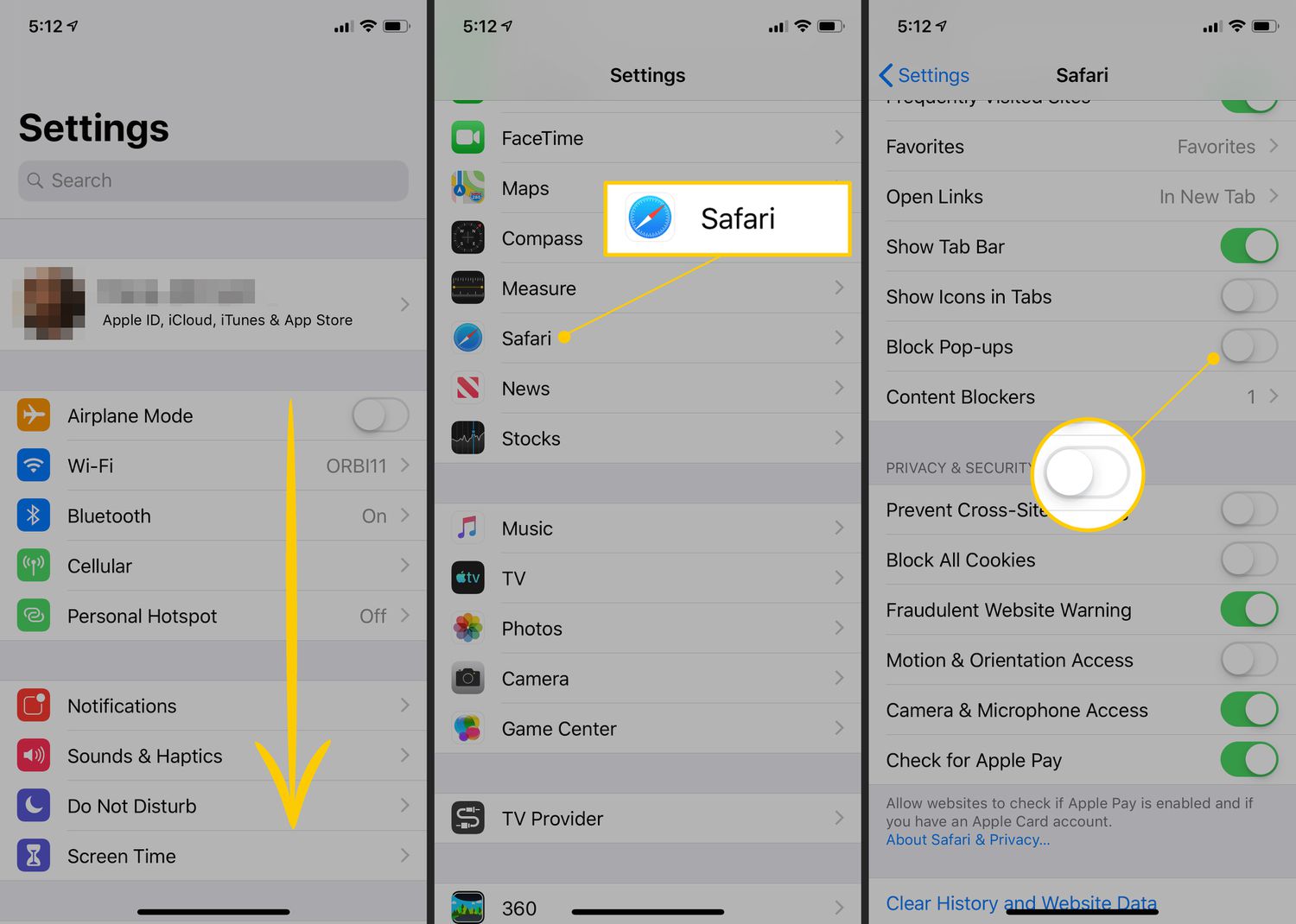
Introduction
Are you an iPhone user who has encountered the frustration of being unable to view pop-up windows while browsing on Safari? Pop-ups can sometimes contain important information or access to specific features on websites, and not being able to view them can be a hindrance. Fortunately, there's a straightforward solution to this issue. By adjusting a few settings in Safari , you can easily allow pop-ups to appear on your iPhone, enhancing your browsing experience and ensuring that you don't miss out on any vital content.
In this guide, we will walk you through the simple steps to enable pop-ups on Safari for your iPhone. Whether you're trying to access a specific feature on a website or simply want to ensure that you don't miss out on any important information, this tutorial will help you navigate the settings and make the necessary adjustments to allow pop-ups to appear seamlessly while you browse.
So, if you've ever found yourself frustrated by the inability to view pop-ups on Safari, fear not! By following the steps outlined in this guide, you'll be able to customize your Safari settings and enjoy a more seamless browsing experience on your iPhone. Let's dive into the steps and get those pop-ups enabled on your Safari browser !
Step 1: Open Safari Settings
To begin the process of allowing pop-ups on Safari for your iPhone, you'll first need to access the settings within the Safari browser . Follow the steps below to open the Safari settings and proceed with enabling pop-ups:
Launch Safari : Locate the Safari app icon on your iPhone's home screen and tap on it to open the browser.
Access Settings : Once Safari is open, look for the "Settings" icon, which resembles a gear or cogwheel, typically located in the lower-right corner of the screen. Tap on this icon to access the Safari settings.
Navigate to Safari Settings : Within the Settings menu, scroll down until you find the section labeled "Safari." Tap on "Safari" to access the specific settings for the browser.
Explore Safari Settings : Upon entering the Safari settings, you'll encounter a range of options that allow you to customize your browsing experience. These settings cover various aspects of Safari's functionality, including privacy, security, and content preferences.
Prepare for Pop-Up Adjustment : While in the Safari settings, take a moment to familiarize yourself with the available options. This will help you navigate to the specific setting that pertains to allowing pop-ups on the browser.
By following these steps, you'll successfully open the Safari settings on your iPhone, setting the stage for the subsequent actions required to enable pop-ups. With the Safari settings readily accessible, you're now ready to proceed to the next step and make the necessary adjustments to allow pop-ups to appear seamlessly while you browse.
Opening the Safari settings is the crucial first step in the process of enabling pop-ups on your iPhone. Once you've successfully accessed the settings, you'll be well-positioned to move on to the next phase, where you'll specifically address the option to allow pop-ups within the Safari browser. Let's continue to the next step and make the necessary adjustments to ensure that pop-ups are permitted on your iPhone's Safari browser.
Step 2: Allow Pop-Ups
Now that you've successfully accessed the Safari settings on your iPhone, it's time to delve into the specific option that pertains to allowing pop-ups within the browser. Follow the steps below to navigate to the pop-up settings and make the necessary adjustments to enable pop-ups on Safari:
Locate the Pop-Up Setting : Within the Safari settings menu, scroll through the available options until you find the setting related to pop-ups. This setting is crucial for controlling the behavior of pop-up windows while you browse on Safari.
Toggle the Pop-Up Blocker : Upon locating the pop-up setting, you'll likely encounter a toggle switch that enables or disables the pop-up blocker. To allow pop-ups to appear on Safari, simply toggle the switch to the "On" or "Allow" position. This action effectively disables the pop-up blocker, ensuring that pop-up windows can display as intended.
Confirm the Changes : After toggling the pop-up blocker to the "On" or "Allow" position, take a moment to ensure that the changes have been successfully applied. This confirmation step is essential for verifying that pop-ups are now permitted within the Safari browser on your iPhone.
By following these steps, you'll effectively allow pop-ups to appear on Safari, enhancing your browsing experience and ensuring that you can access all relevant content and features without hindrance. With the pop-up blocker disabled, you'll no longer encounter restrictions when attempting to view pop-up windows while browsing on Safari.
Enabling pop-ups on Safari can be particularly beneficial when accessing certain websites or utilizing specific features that rely on pop-up windows for functionality. By customizing the pop-up settings to allow their display, you're empowering yourself to make the most of your browsing experience on your iPhone.
With the pop-up settings adjusted and pop-ups now permitted on Safari, you're well on your way to enjoying a more seamless and unrestricted browsing experience on your iPhone. The next step involves testing the functionality of pop-ups to ensure that they display as intended. Let's proceed to the next step and verify that pop-ups are now allowed on your Safari browser.
Step 3: Test Pop-Ups
After enabling pop-ups on Safari for your iPhone, it's essential to verify that the changes have been successfully implemented. Testing the functionality of pop-ups will allow you to ensure that they display as intended, providing you with the confidence that you can seamlessly access pop-up windows while browsing. Follow the steps below to test pop-ups on Safari and confirm that they are now allowed on your iPhone:
Visit a Website with Known Pop-Ups : To begin the testing process, navigate to a website that is known to utilize pop-up windows. This could be a site that you frequently visit and have previously encountered pop-ups on, or a platform that is recognized for incorporating pop-up functionality as part of its user experience.
Interact with Pop-Up Triggers : Once on the website, engage with the elements that typically trigger pop-up windows. This could involve clicking on specific links, buttons, or interactive elements that are designed to generate pop-ups. By interacting with these triggers, you'll prompt the website to display pop-up windows, allowing you to observe their behavior in response to your actions.
Observe Pop-Up Display : As you interact with the pop-up triggers, pay close attention to how the pop-up windows behave. If pop-ups are successfully allowed on Safari, you should see them display seamlessly in response to the triggers you engage with on the website. Take note of the content within the pop-up windows and ensure that they appear without any hindrance.
Verify Accessibility and Functionality : In addition to observing the display of pop-up windows, verify that you can interact with the content within the pop-ups as intended. This may involve clicking on buttons, filling out forms, or accessing specific information presented within the pop-up windows. By confirming the accessibility and functionality of pop-ups, you can ensure that they are fully operational on Safari for your iPhone.
By testing the functionality of pop-ups on Safari, you can confirm that the changes made to the settings have effectively allowed pop-ups to display as intended. This verification process is crucial for ensuring that you can seamlessly access and interact with pop-up windows while browsing on your iPhone. With pop-ups now permitted on Safari, you can navigate websites with confidence, knowing that you won't encounter restrictions when it comes to viewing essential content or utilizing specific features that rely on pop-up functionality.
Testing pop-ups on Safari serves as the final step in the process of enabling pop-ups on your iPhone. By successfully confirming the display and functionality of pop-up windows, you can rest assured that your browsing experience on Safari is now enhanced, allowing you to make the most of the content and features available on various websites.
In conclusion, by following the simple yet essential steps outlined in this guide, you've successfully enabled pop-ups on Safari for your iPhone. The ability to allow pop-ups ensures that you can seamlessly access vital content, engage with interactive features, and make the most of your browsing experience without encountering restrictions.
Opening the Safari settings and navigating to the specific option that controls pop-ups allowed you to customize your browsing experience to suit your preferences. By toggling the pop-up blocker to the "On" or "Allow" position, you effectively disabled the restrictions that previously hindered the display of pop-up windows while browsing on Safari.
Furthermore, testing the functionality of pop-ups provided you with the confidence that the changes made to the settings have been successfully implemented. By interacting with pop-up triggers on websites and observing the seamless display and functionality of pop-up windows, you verified that pop-ups are now fully operational on Safari for your iPhone.
With pop-ups now permitted on Safari, you can navigate websites with ease, knowing that you won't miss out on important information or features that rely on pop-up functionality. Whether you're accessing specific content, engaging with interactive elements, or utilizing essential features on websites, the ability to view pop-ups seamlessly enhances your overall browsing experience on your iPhone.
By empowering yourself to customize the pop-up settings on Safari , you've taken a proactive step towards ensuring a more seamless and unrestricted browsing experience. The ability to allow pop-ups on Safari not only enhances your accessibility to content and features but also provides you with the flexibility to engage with a wide range of interactive elements that contribute to a richer browsing experience.
In essence, by enabling pop-ups on Safari for your iPhone, you've personalized your browsing environment to align with your preferences, ensuring that you can make the most of the content and features available on various websites. With pop-ups now allowed on Safari, you're well-equipped to enjoy a more dynamic and interactive browsing experience, free from the limitations that previously hindered the display of essential pop-up windows.
Congratulations on successfully enabling pop-ups on Safari for your iPhone, and may your browsing experience be enriched by the seamless accessibility to a wide array of content and interactive features across the web.
Leave a Reply Cancel reply
Your email address will not be published. Required fields are marked *
Save my name, email, and website in this browser for the next time I comment.
- Crowdfunding
- Cryptocurrency
- Digital Banking
- Digital Payments
- Investments
- Console Gaming
- Mobile Gaming
- VR/AR Gaming
- Gadget Usage
- Gaming Tips
- Online Safety
- Software Tutorials
- Tech Setup & Troubleshooting
- Buyer’s Guides
- Comparative Analysis
- Gadget Reviews
- Service Reviews
- Software Reviews
- Mobile Devices
- PCs & Laptops
- Smart Home Gadgets
- Content Creation Tools
- Digital Photography
- Video & Music Streaming
- Online Security
- Online Services
- Web Hosting
- WiFi & Ethernet
- Browsers & Extensions
- Communication Platforms
- Operating Systems
- Productivity Tools
- AI & Machine Learning
- Cybersecurity
- Emerging Tech
- IoT & Smart Devices
- Virtual & Augmented Reality
- Latest News
- AI Developments
- Fintech Updates
- Gaming News
- New Product Launches

How to Use Email Blasts Marketing To Take Control of Your Market
Learn to convert scanned documents into editable text with ocr, related post, how to make stairs planet coaster, how to rotate camera in planet coaster, how to make a good roller coaster in planet coaster, where is the minecraft folder, how to update minecraft windows, how to update minecraft education edition, related posts.
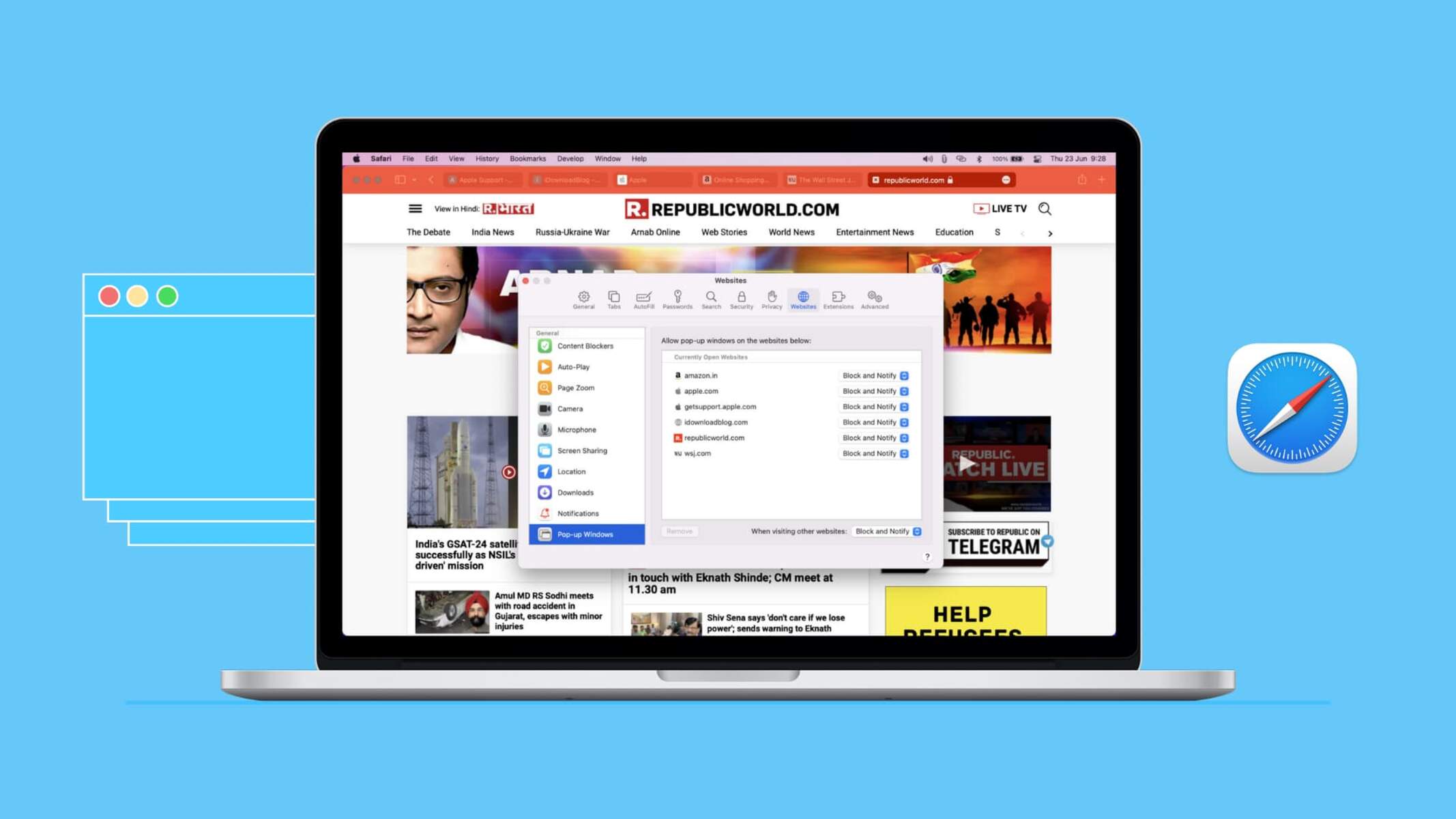
How To Unblock Pop-Ups On IPhone Safari

How To Turn Off Pop-Up Blocker On IPhone Safari
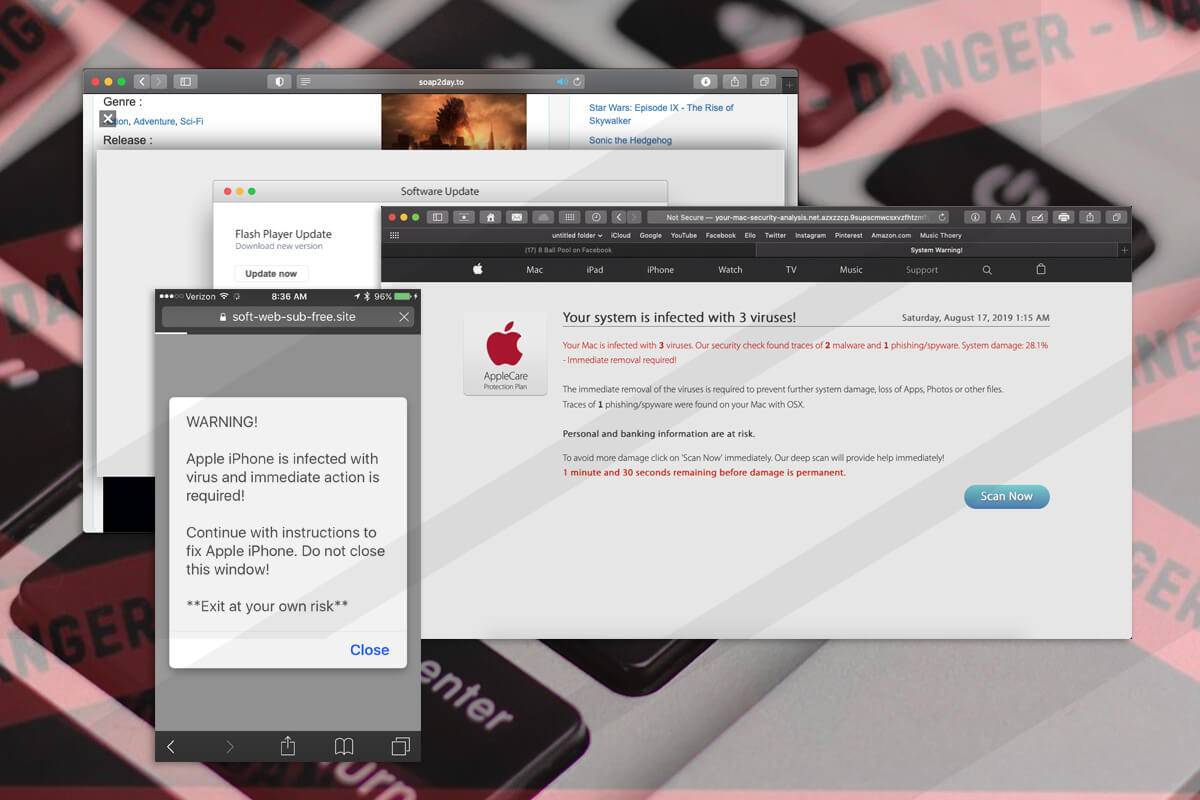
How To Remove Virus From Safari On IPhone
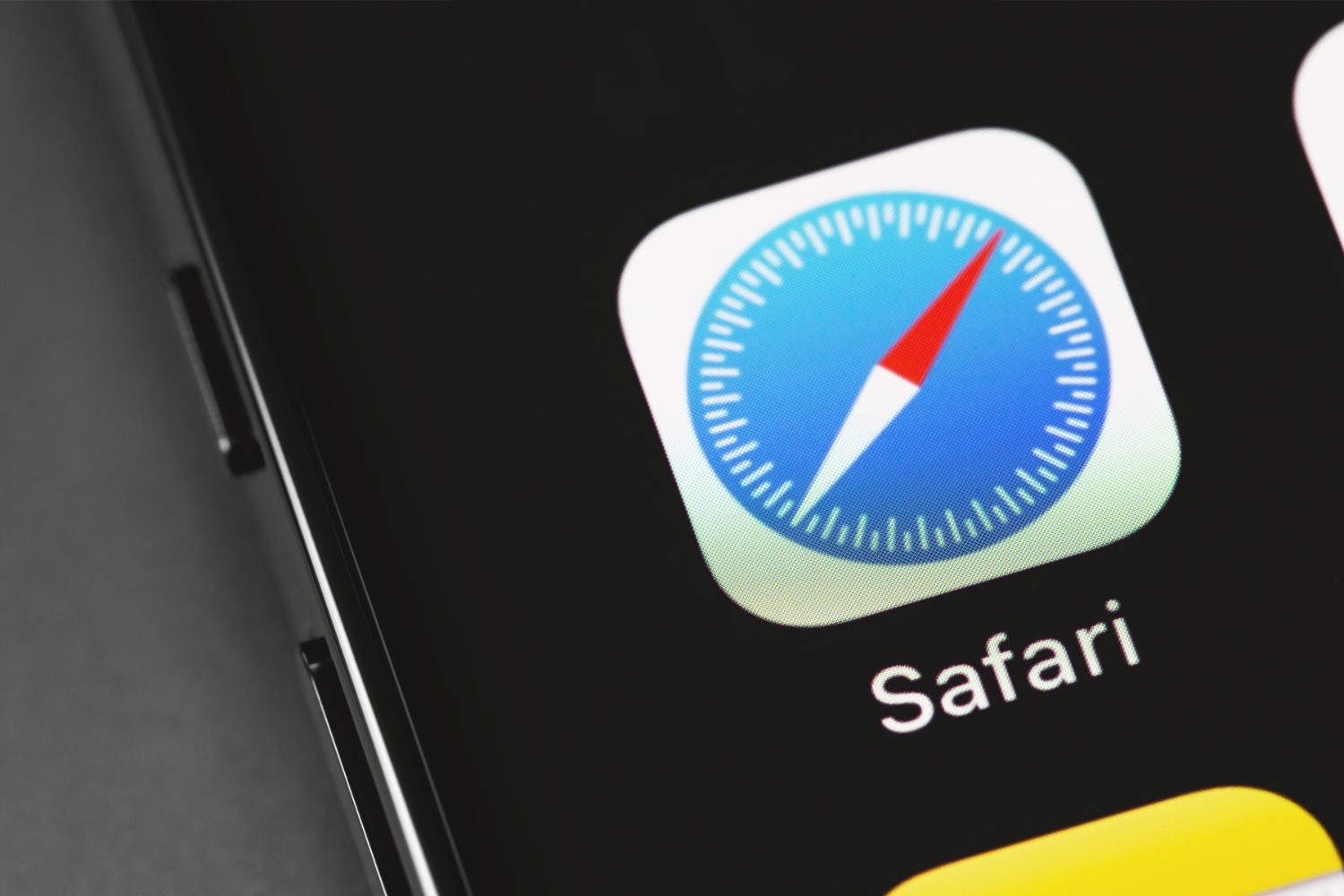
How To Enable Safari On IPhone
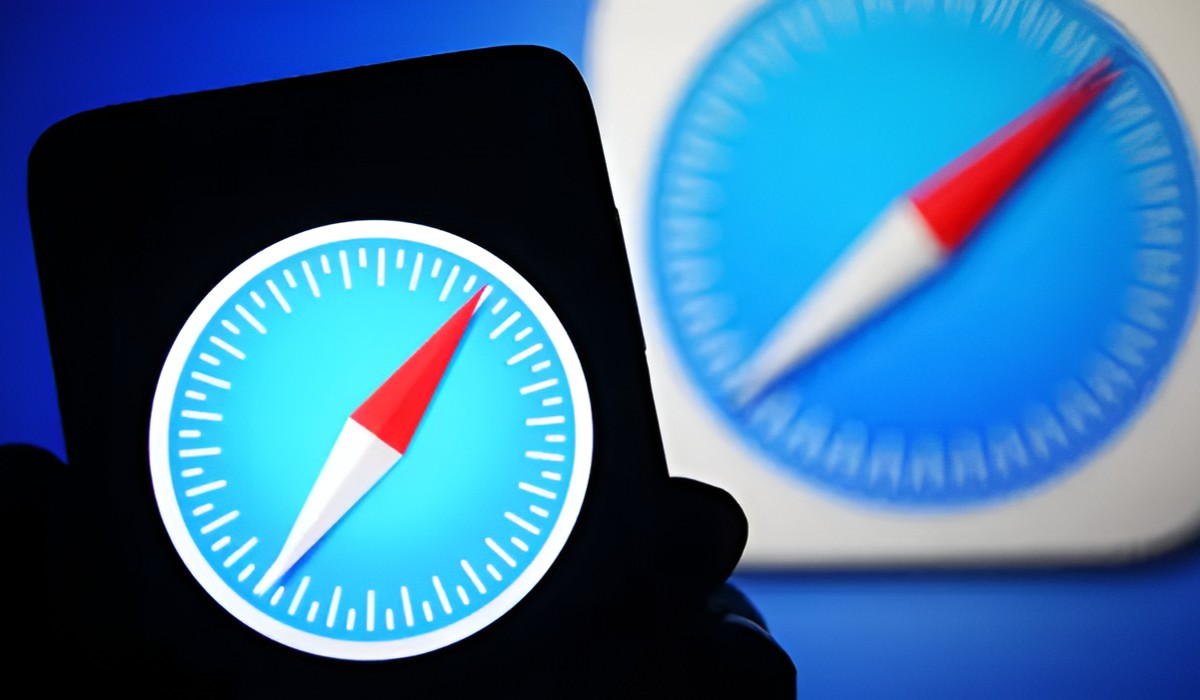
How To Go To Safari Settings On IPhone
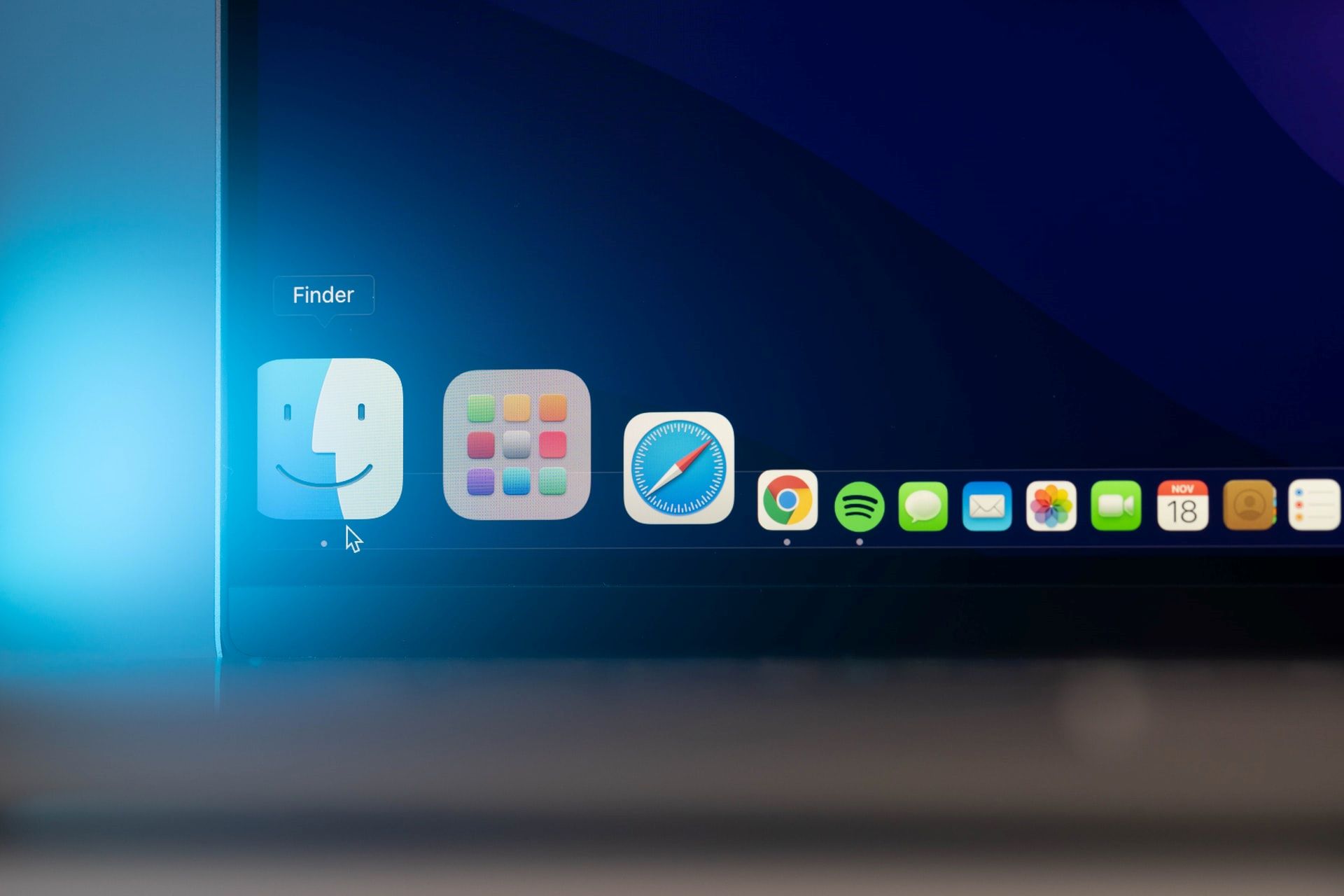
How Do I Get To Safari Browser
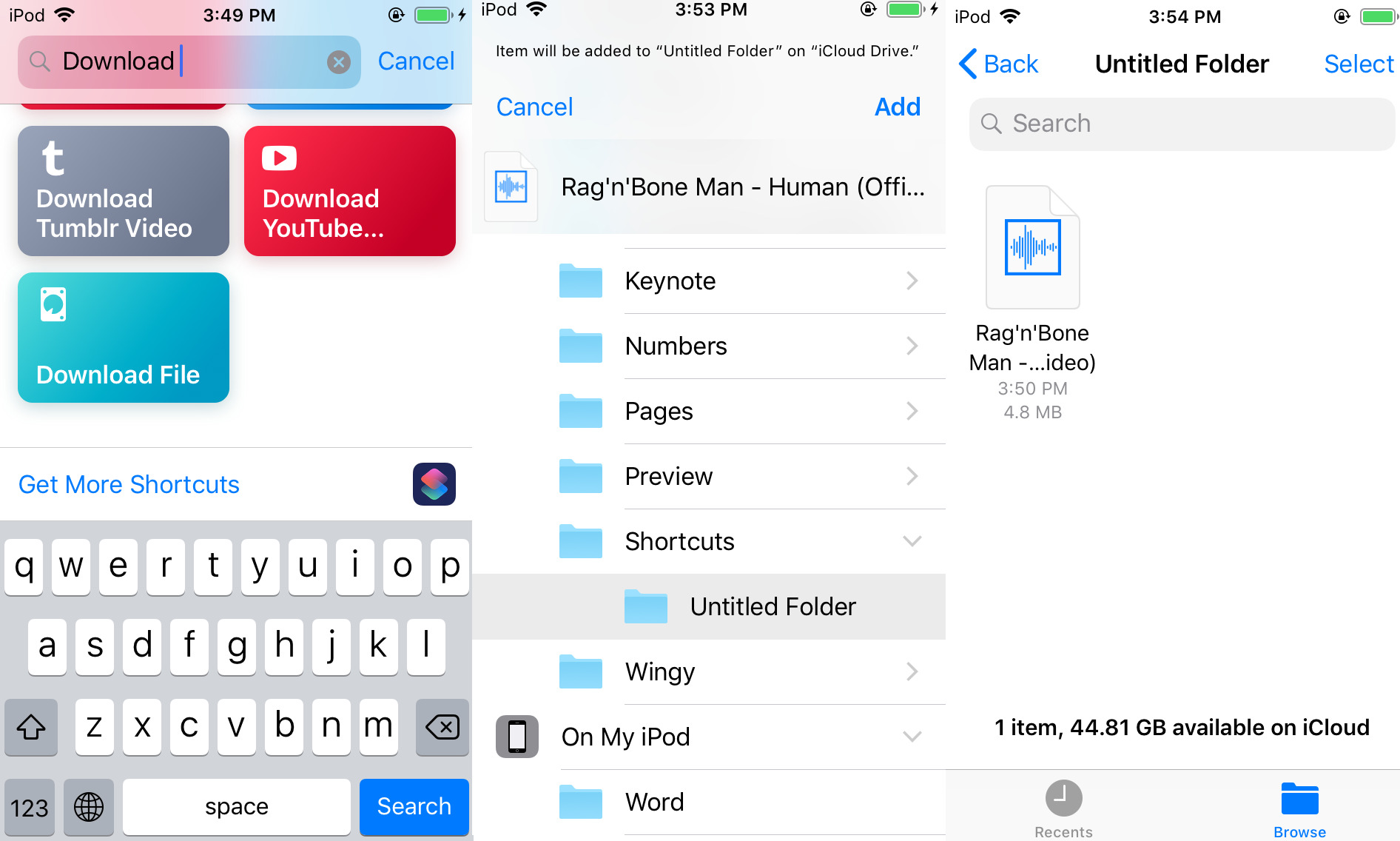
How To Download A File On IPhone
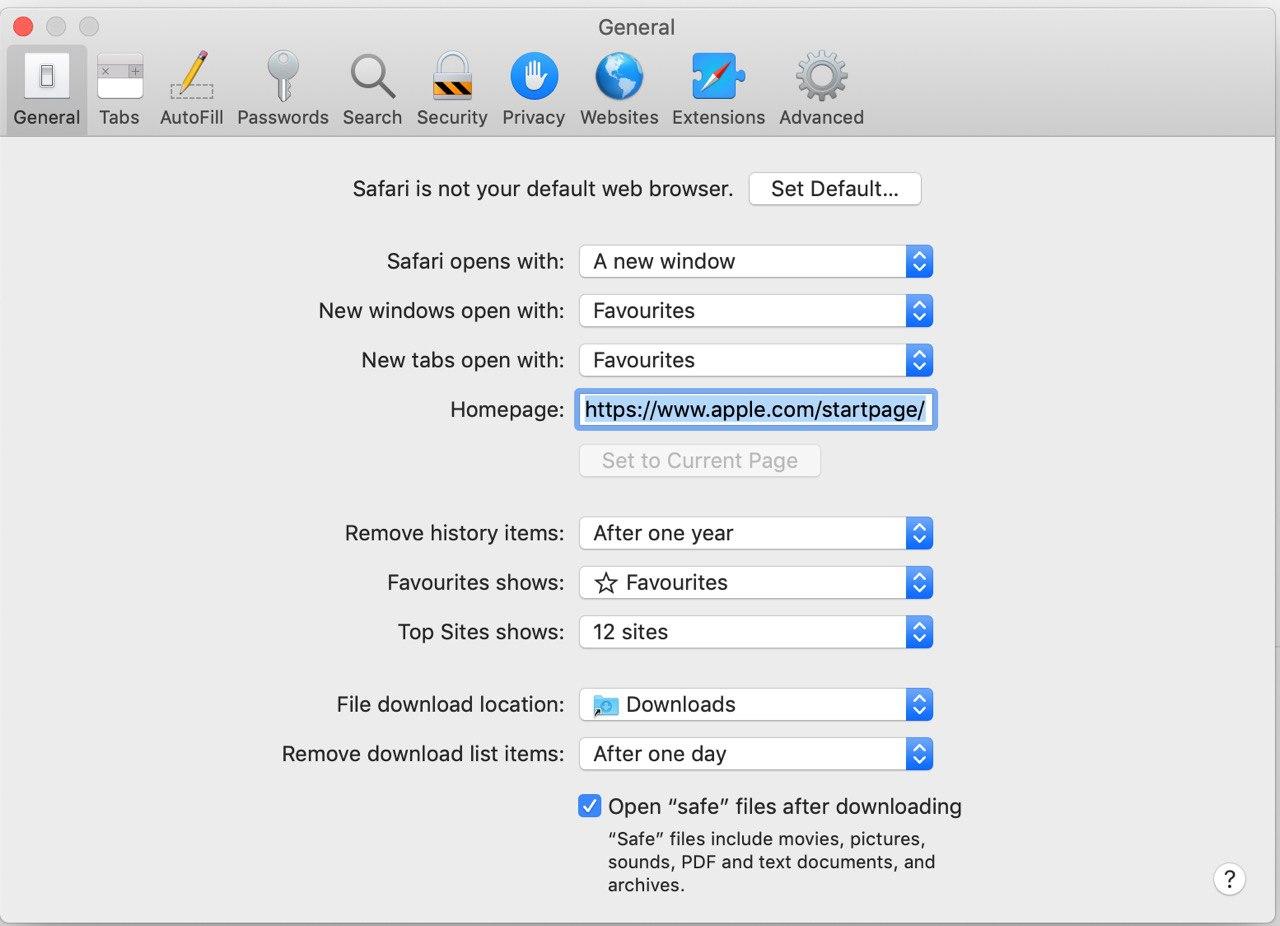
Where Is Settings On Safari
Recent stories.

Top Mini Split Air Conditioner For Summer

Comfortable and Luxurious Family Life | Zero Gravity Massage Chair

Fintechs and Traditional Banks: Navigating the Future of Financial Services

AI Writing: How It’s Changing the Way We Create Content

How to Find the Best Midjourney Alternative in 2024: A Guide to AI Anime Generators

How to Know When it’s the Right Time to Buy Bitcoin

- Privacy Overview
- Strictly Necessary Cookies
This website uses cookies so that we can provide you with the best user experience possible. Cookie information is stored in your browser and performs functions such as recognising you when you return to our website and helping our team to understand which sections of the website you find most interesting and useful.
Strictly Necessary Cookie should be enabled at all times so that we can save your preferences for cookie settings.
If you disable this cookie, we will not be able to save your preferences. This means that every time you visit this website you will need to enable or disable cookies again.
How to Allow Pop-Ups in Safari
Safari blocks all pop-up windows by default, which isn't always ideal, as you'll face issues while visiting old websites.
Over the past few years, Apple has positioned Safari as a privacy-first web browser. And it's one of the many reasons Apple users prefer it to popular alternatives like Google Chrome or Firefox.
The ability to block pop-ups in Safari automatically is one of the most praised features in the bunch. However, there are times when you need to allow pop-ups in Safari. So, we'll explain how you can allow pop-ups in Safari on an iPhone, iPad, or Mac.
How to Allow Pop-Ups in Safari on a Mac
You can allow pop-ups for all websites or a specific site in Safari. We'll show you how to do both, but if you use another browser, you may need an extensive guide on how to allow pop-ups on Mac in general.
How to Allow Pop-Ups for a Specific Website
Enabling pop-ups for a website you trust or visit frequently is pretty easy. Here's what you need to do.
- Visit the website for which you want to allow pop-ups in Safari.
- Control -click on the URL in the address bar and choose Settings for [Website URL] from the context menu.
- Then, click the dropdown next to Pop-up Windows and choose Allow .
From now on, Safari will allow pop-up windows on the specific website.
How to Allow Pop-Ups Across Safari
Likewise, you can enable pop-up windows for all sites you access in Safari. Follow these steps:
- Launch Safari and click Safari > Settings from the menu bar.
- Head to the Websites tab in the window that appears.
- Now, select Pop-up Windows from the left sidebar.
- Click the dropdown next to When visiting other websites at the bottom-right corner and choose Allow .
As you can see, it's pretty easy to allow pop-ups for all sites you visit in Safari. However, we recommend keeping the Block option unless you want to be bombarded with pop-ups.
How to Allow Pop-Ups in Safari on an iPhone or iPad
Allowing pop-ups in Safari on an iPhone or iPad is also pretty straightforward. Once again, you may need a more extensive guide to allow pop-ups on an iPhone or iPad if you use third-party browsers. Regardless, here's what you need to do.
- Launch the Settings app, scroll down, and tap on Safari .
- Scroll down to the General subsection.
- Toggle off& Block Pop-ups to enable pop-ups.
Unfortunately, there's no option to allow pop-ups for specific websites in iOS and iPadOS. So, you'll have to deal with pop-up windows across Safari when you disable this option.
When Should You Allow Pop-Ups in Safari?
Even though pop-ups are mostly used for annoying advertisements, some legitimate sites use pop-ups. For example, some websites use pop-up windows for payments so that the user can process the payment without leaving the current page. They're also used to facilitate customer service interactions.
You may also need pop-up windows to use specific features on some websites. This could be the case when using less modern websites. However, by default, you'll find that Safari blocks all pop-up windows. Regardless of how many times you click a button, the pop-up will not appear.
Fortunately, you now have better ways to control how pop-ups behave in Safari on an iPhone, iPad, and Mac. Nevertheless, you should only allow pop-ups in Safari when you're confident about the security and privacy of the website. Also, you should check the different aspects of allowing pop-ups in your browser before you proceed.
Change How Safari Handles Pop-Ups
While it has risks, allowing pop-up windows in Safari is an easy task. As we said, it will be useful when dealing with old websites or those with Google Sign-In options. If you're a developer, this option will also help you with testing.
However, considering how problematic they can be, pop-up windows should be enabled only in safe environments, and disabling pop-up blocking across your device may not be a good idea.
iOS 17: How to Allow Pop-Ups on iPhone – A Step-by-Step Guide
Allowing pop-ups on your iPhone can be a handy feature when you need it. Especially with the latest iOS 17 update, you might find yourself in need of quick access to pop-up content. Don’t worry, it’s a simple process that even a tech newbie can handle.
You can also watch this video about how to allow pop ups on iPhone for additional info.
How to Allow Pop-Ups on iPhone with iOS 17
Before we dive into the steps, let’s clarify what we’re achieving here. By following these instructions, you’ll enable pop-ups in Safari, the default web browser on your iPhone. This can be useful for certain websites that require pop-up windows to function correctly.
Step 1: Open Settings
Open the ‘Settings’ app on your iPhone.
The ‘Settings’ app is typically found on your home screen and has a gear icon. You’ll need to scroll a bit to find Safari settings.
Step 2: Scroll to Safari
Scroll down and tap on ‘Safari’ to open the browser settings.
Safari settings are where you can adjust various aspects of your web browsing experience, such as privacy, security, and content settings.
Step 3: Find the ‘Block Pop-ups’ option
In Safari settings, look for the ‘Block Pop-ups’ option.
It’s usually located under the ‘General’ section within the Safari settings. This toggle determines whether pop-ups are allowed or blocked.
Step 4: Toggle off ‘Block Pop-ups’
Tap the toggle switch next to ‘Block Pop-ups’ to turn it off.
The switch will turn from green to gray, indicating that the pop-up blocker is now disabled.
After completing these steps, your iPhone will now allow pop-up windows when you’re browsing with Safari. This means that any site that needs to show pop-ups will now do so without being blocked.
Tips for Managing Pop-Ups on iPhone with iOS 17
- Be selective about which sites you allow pop-ups for, as some can be intrusive or malicious.
- Consider using content blockers or ad blockers to manage unwanted pop-ups while still allowing necessary ones.
- If a pop-up seems suspicious, avoid interacting with it and close it immediately.
- Keep your iOS updated to ensure the latest security features and pop-up management tools.
- Regularly review your Safari settings to ensure they still align with your browsing preferences and safety standards.
Frequently Asked Questions
What are pop-ups.
Pop-ups are new browser windows or tabs that open automatically without your direct input, often prompted by a website’s script.
Is it safe to allow pop-ups?
It can be safe as long as you trust the website you’re allowing pop-ups for. Always exercise caution and use reliable security software.
Can I allow pop-ups for specific websites?
Yes, in Safari settings, you can manage site-specific settings, including allowing pop-ups for individual sites.
Will disabling the pop-up blocker affect all browsers on my iPhone?
No, these steps specifically apply to Safari. Other browsers will have their own settings.
Can I quickly toggle the pop-up blocker back on?
Yes, simply return to Safari settings and toggle the ‘Block Pop-ups’ option back to on (green).
- Open Settings
- Scroll to Safari
- Find the ‘Block Pop-ups’ option
- Toggle off ‘Block Pop-ups’
The ability to allow pop-ups on your iPhone with iOS 17 can be incredibly useful, especially when navigating websites that require pop-up functionality to offer a full user experience. Remember, though, with great power comes great responsibility. Allowing pop-ups means you need to be extra vigilant about your online safety. Make sure the sites you’re allowing pop-ups for are trustworthy and secure. It’s also a good idea to occasionally review your settings to make sure they’re still configured to your preferences. Allowing pop-ups is just one of the many customizable features on your iPhone that puts you in control of your online experience. Keep exploring, stay safe, and make the most of your technology with iOS 17.

Matt Jacobs has been working as an IT consultant for small businesses since receiving his Master’s degree in 2003. While he still does some consulting work, his primary focus now is on creating technology support content for SupportYourTech.com.
His work can be found on many websites and focuses on topics such as Microsoft Office, Apple devices, Android devices, Photoshop, and more.
Share this:
- Click to share on Twitter (Opens in new window)
- Click to share on Facebook (Opens in new window)
Related Posts
- How to Allow Pop Ups in Safari on an iPhone 7: A Step-by-Step Guide
- How to Allow Pop Ups on iPhone 15: A Step-by-Step Guide
- How to Allow Pop Ups in the Chrome iPhone App: A Step-by-Step Guide
- How to Turn Off Pop Up Blocker on iPhone Safari: A Guide
- iOS 17: How to Disable Pop-Up Blocker on iPhone
- How to Change the Pop Up Blocker iPhone 13 Setting
- iOS 17: How to Block Pop-Ups in Chrome on iPhone Easily
- How to Turn Off Pop Up Blocker on iPhone 13
- How to Allow Pop Ups on an iPhone 11
- How to View Safari History on iPhone
- How to Disable the iPhone 14 Pop Up Blocker
- How to Disable the Pop Up Blocker on an iPhone 7
- How to Change the Default iPhone 13 Web Browser
- How to Stop Blocking Pop Ups in Chrome on an iPhone
- iPhone 15: How to Clear Safari History in Just a Few Steps
- How to Remove Safari Frequently Visited on iPhone 13
- How to Get Safari Back on iPhone 13: A Step-by-Step Guide
- How to Clear Browsing History on iPhone 14
- How to Allow Cookies on iPhone 15: A Step-by-Step Guide
- Disabling Safari Extensions on iOS 17: A Step-by-Step Guide
Get Our Free Newsletter
How-to guides and tech deals
You may opt out at any time. Read our Privacy Policy
- Security Tips
- Social Media
- Privacy Tips
- Performance Tips
How to Allow or Block Pop-Ups in Safari
Random pop-up windows are annoying, but some pop-ups are actually useful. So, when should you allow or block pop-ups in Safari? Keep reading to learn about the different types of pop-ups, how to block pop-ups on Mac devices, and how to disable the Safari pop-up blocker. Or use AVG Secure Browser to manage and filter pop-up ads automatically.
Get it for PC , Mac , iOS
Get it for Android , iOS , Mac
Get it for iOS , Android , PC
Get it for Mac , PC , Android
/Signal-How-to-allow-and-block-pop-ups-in-Safari-Hero.jpg?width=1200&name=Signal-How-to-allow-and-block-pop-ups-in-Safari-Hero.jpg)
How to block Safari pop-ups on Mac
Though sometimes helpful, pop-ups don’t have a great reputation. They can interrupt your work, slow page-load times, or even conceal malicious software. Thankfully, blocking pop-ups in Safari is easy, because the browser features a built-in pop-up blocker to help you manage them.
On Mac devices, Safari’s pop-up blocker lets you block or allow pop-ups for specific websites . This is an important feature in a blocker, because not all pop-ups are spam messages and some help you navigate and use sites more easily.
You can also choose to block or allow pop-ups on specific sites with AVG Secure Browser , a free browser that puts security and privacy at the forefront. You can surf the web anonymously and fully customize your ad blocker to allow only essential pop-ups. Plus, you’ll enjoy a host of additional privacy features.
How to block all pop-ups on Mac
Here’s how to stop all pop-ups on Mac using the Safari pop-up blocker:
Open the Safari browser and click Preferences under the Safari drop-down menu.
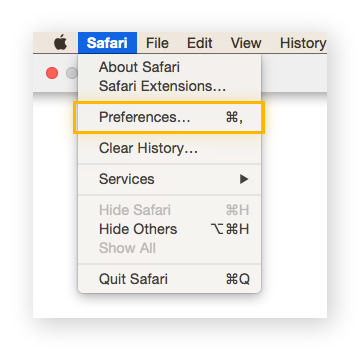
Select the Websites tab at the top and click Pop-up Windows on the left menu.
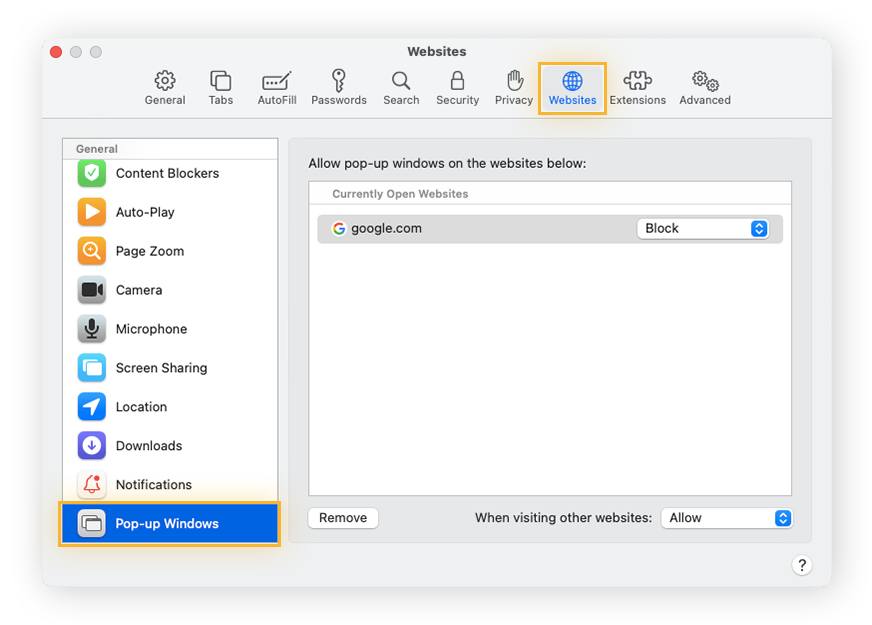
Use the Remove button to clear any site settings displayed in the “Configured Websites” box. Then click the “When visiting other websites” button and select Block .
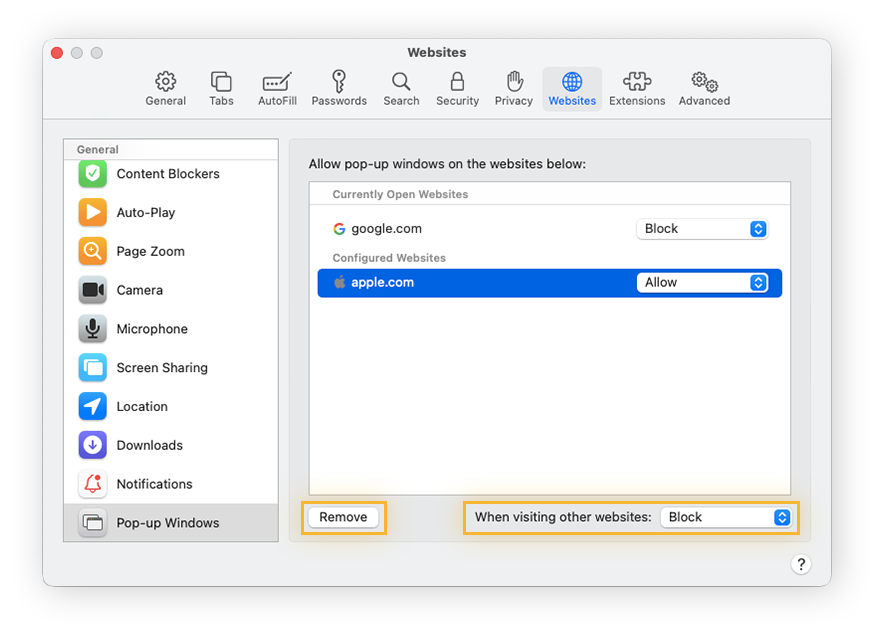
You’re done — Safari pop-ups blocker is now active for all websites.
Like clearing your search history , deleting cookies , and removing extensions from Safari , blocking pop-ups can streamline and speed up your Mac , because it minimizes spam adverts and reduces other disruptive notifications.
How to disable pop-ups for specific sites on Mac
If Safari is blocking pop-ups that you want or need to see, you can customize your pop-up settings and block pop-ups for certain sites.
Here’s how to turn off pop-ups on specific sites on Mac:
Open Safari and click Preferences under the Safari drop-down menu.
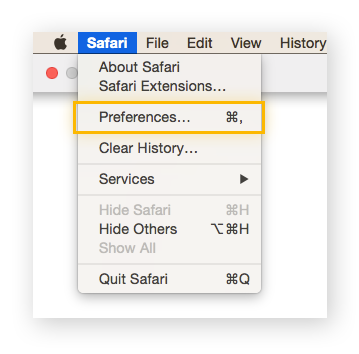
Select the Websites tab and click Pop-up windows in the left menu. Set “When visiting other websites” to Allow to enable pop-ups as the default setting.
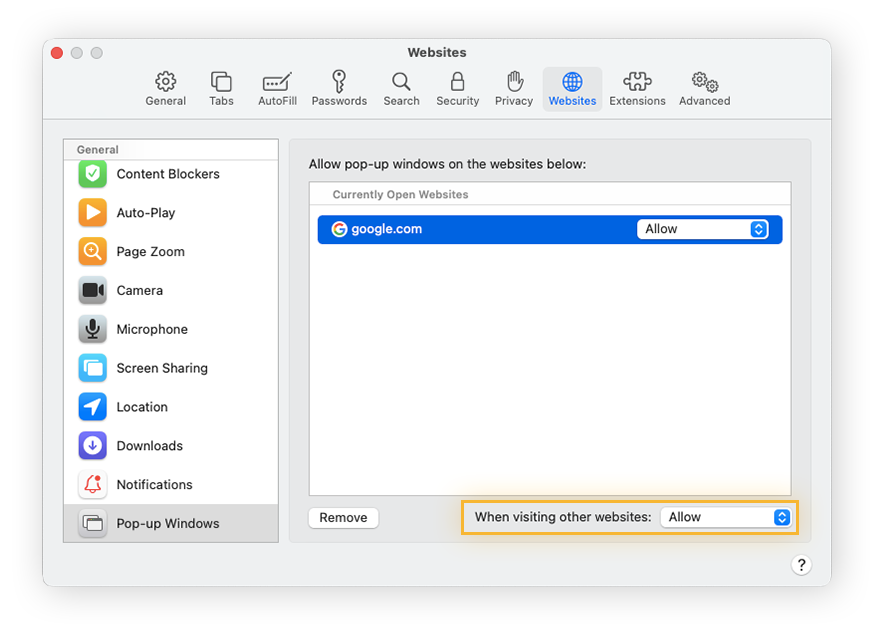
The website you’re on will be listed in the Currently Open Websites area. Click the drop-down menu and choose Block .
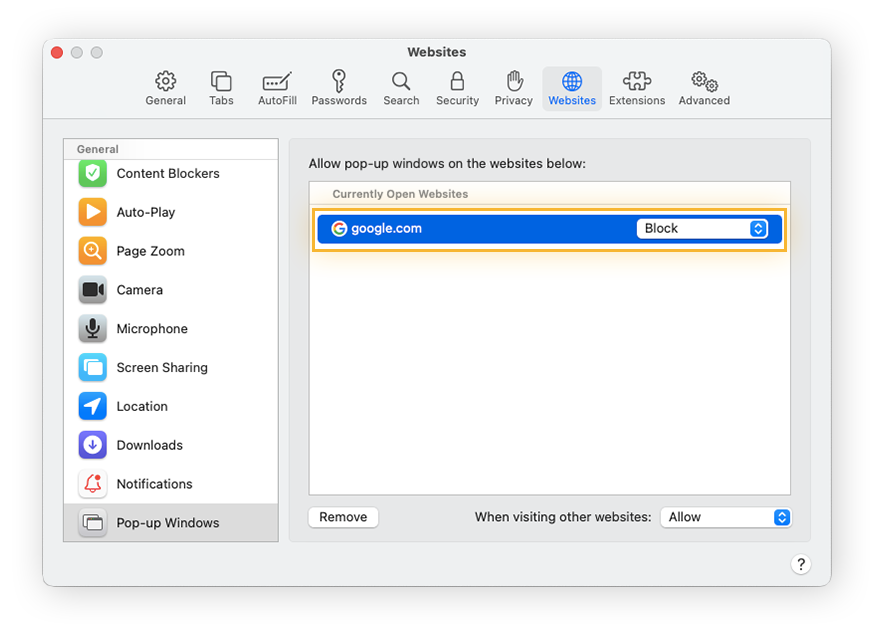
Pop-ups will now be blocked for the website you’ve chosen, and you can repeat the process for other sites you want to block. If you’re looking for more ways to curate a more minimalist browsing experience, you can also try setting the about:blank page as your browser homepage.
How to block pop-ups for an active website
You can set Mac’s pop-up blocker to disable pop-ups only for the website you’re currently using.
Here’s how to block pop-ups on Mac on the website you’re actively using:
Right click on the address bar of the current website and click Settings for this website .
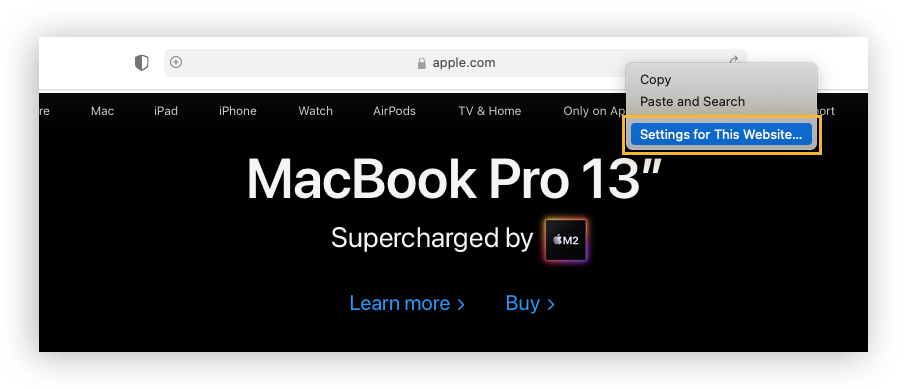
In the settings window, select Block from the drop-down menu next to Pop-up Windows .
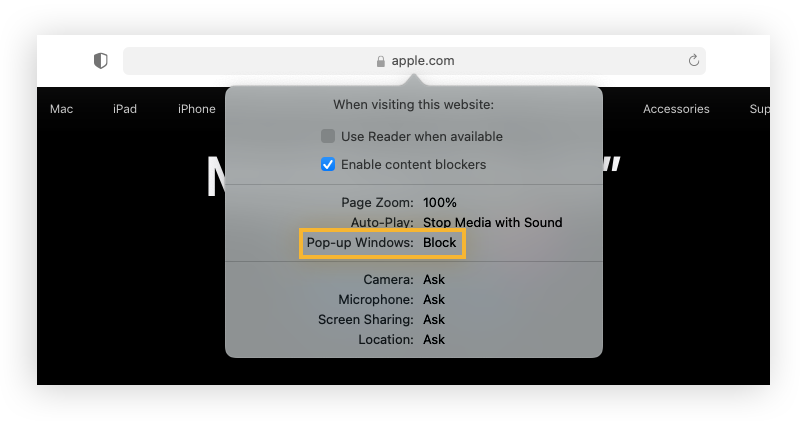
Safari will now block pop-up messages on that site, but your Mac will continue to allow pop-ups from other websites.
How to block Safari pop-ups on iPhone and iPad
Pop-ups also affect mobile devices, but fortunately Safari has a pop-up blocker for iPhone and iPad too.
Here’s how to block pop-ups on iPhones and iPads:
Go to Settings and tap the Safari app.
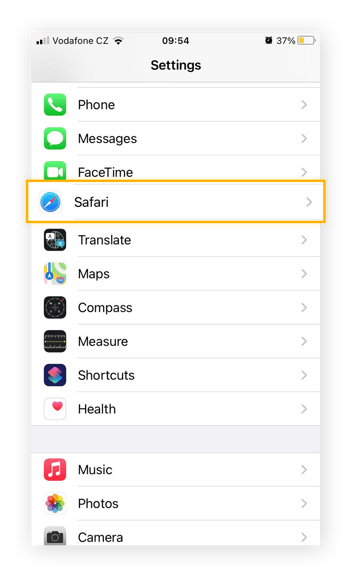
Scroll to Block Pop-ups and toggle the button on .
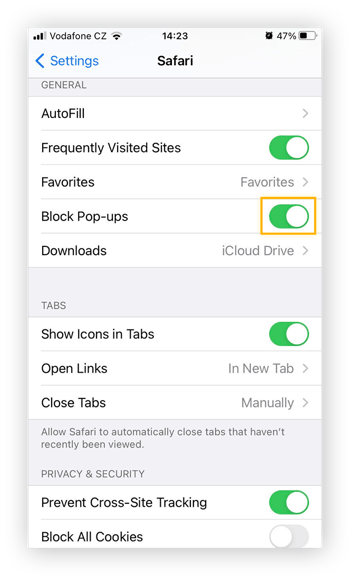
Just as computers can slow down over time , iPhones can get weighed down with more than just pop-ups. Take additional steps to clean and speed up your iPhone to keep it running at its best.
If you also use other browsers, you can manage pop-ups in Chrome , prevent pop-ups in Firefox , or get rid of them in Edge or IE . Using a browser cleaner tool will also help to speed up your device .
How to disable the pop-up blocker on Mac
Some pop-up messages are helpful, because they’re designed to improve your user experience by conveying helpful notifications or maintaining site functionality. So if you disable a pop-up blocker on Safari — meaning you allow pop-ups — you might improve your web browsing experience.
Here’s how to enable pop-ups on Mac:
Click the Safari drop-down menu and select Preferences .
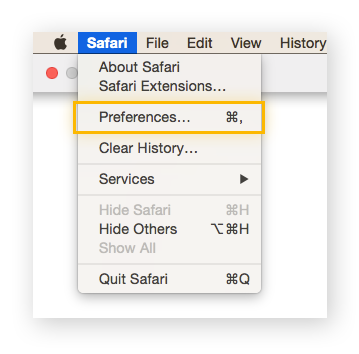
Click the Websites tab at the top and select Pop-up windows from the left menu. If there are any individual site settings displayed in the “Configured Websites” box, delete them using the Remove button.
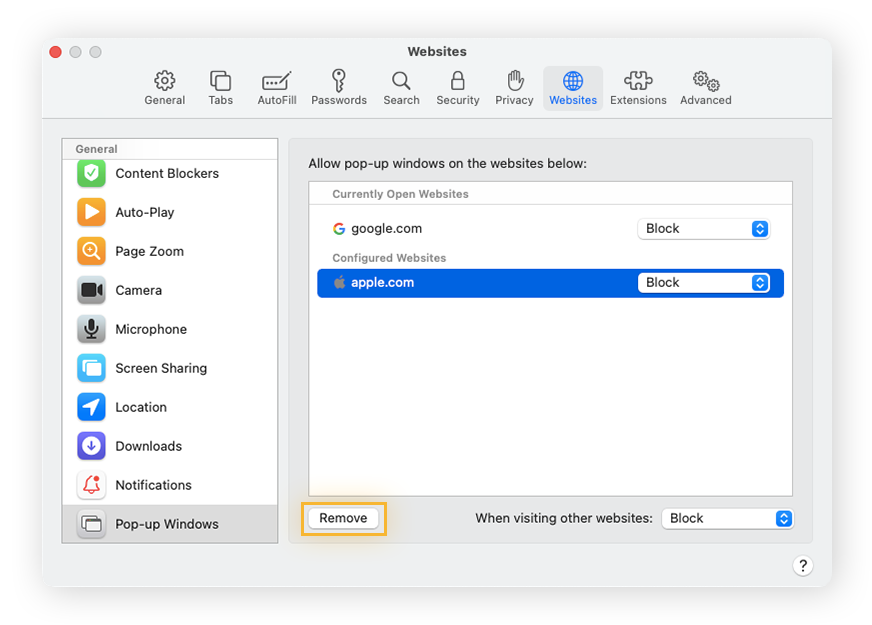
Set the “When visiting other websites” button to Allow .
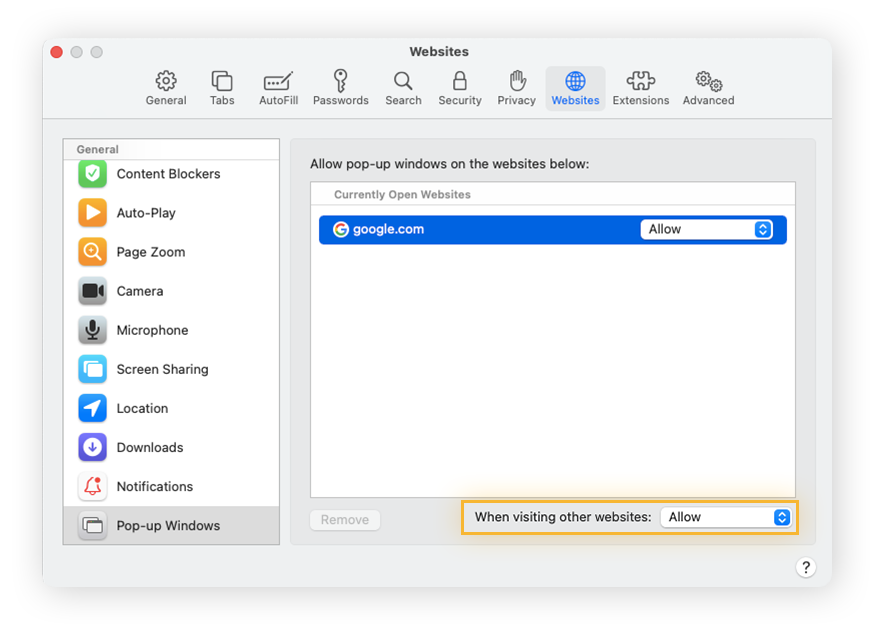
And there you have it — all pop-ups are now allowed on Safari.
How to allow pop-ups for specific sites on Mac
If you want to unblock pop-ups only for sites you trust, you can customize your Safari preferences on Mac to allow pop-ups on certain sites, while leaving the pop-up blocker active for others.
Here’s how to enable pop-ups on Mac for specific sites:
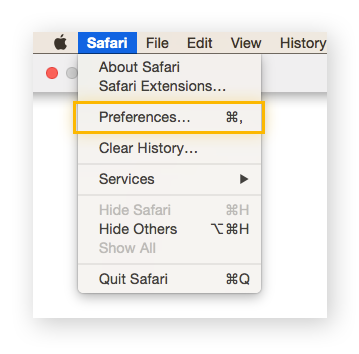
Select the Websites tab and click Pop-up windows . The website you’re on will be listed in the Currently Open Websites area. Click the drop down menu and choose Allow .
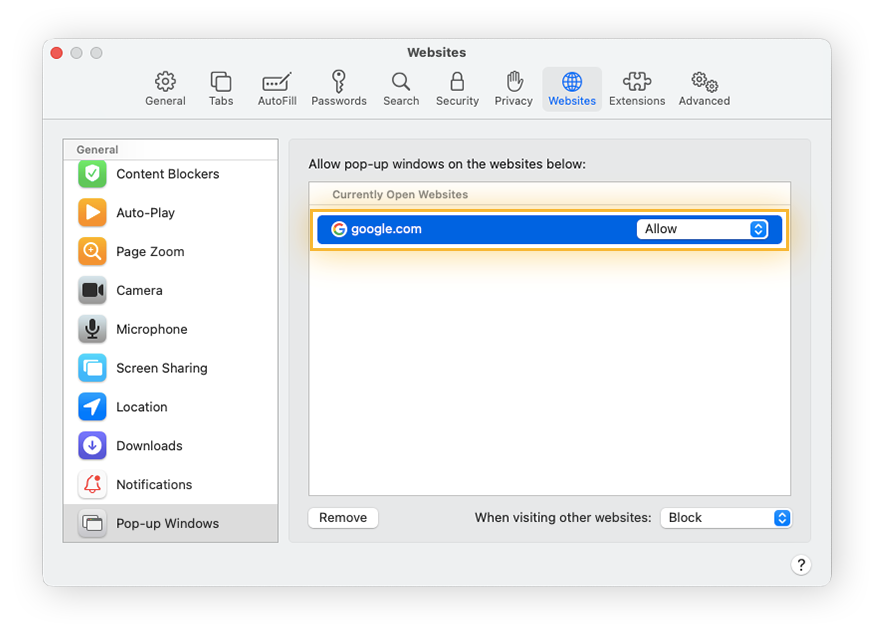
Once you know how to turn off a pop-up blocker for specific websites, you can further customize your Macbook pop-up blocker by selecting “Block and Notify.” This will allow blocked pop-up windows to be manually displayed if you click the notification in the address bar.
How to allow pop-ups for an active website
Here’s how to disable the pop-up blocker on Mac for the website you’re actively using:
Right click the address bar of the website you’re actively using and select Settings for This Website .

In the settings window, find Pop-up Windows , and select Allow from the drop-down menu.
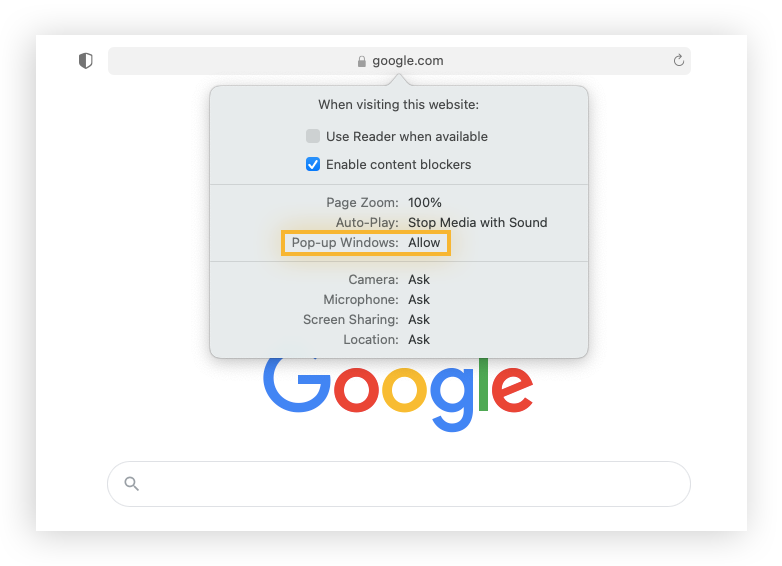
The Safari pop-up blocker will now allow pop-ups from the site you’re currently on — and any other websites that you’ve also unblocked. But Safari’s pop-up blocker will continue to eliminate pop-ups from all other sites.
How to disable the pop-up blocker on iPhone and iPad
On iOS, it’s not possible to make an exception to enable pop-ups from specific sites. If you want any pop-ups at all, you have to completely turn off the pop-up blocker on your iPhone or iPad.
Here’s how to allow pop-ups on iPhone and how to disable the pop-up blocker on iPad:
Go to Settings and choose the Safari app.
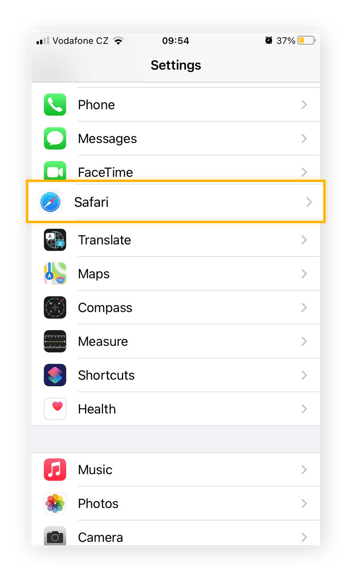
Scroll to Block Pop-ups and toggle the button off .
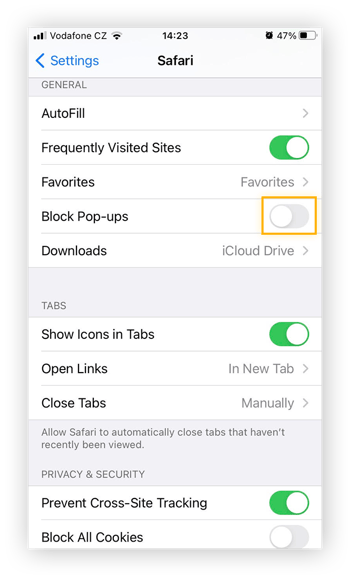
Are pop-ups in Safari dangerous?
Most Safari pop-ups aren’t dangerous and actually help you interact with the websites you visit more easily. Pop-ups can help you interact with a site, let you select preferences, display marketing messages, or show cookie consent forms. If you allow a site to display pop-ups in your browser, you can always clear your cache and disable cookies later to get rid of them.
But there are more dubious and even dangerous pop-ups that can contain false close buttons that actually run unexpected actions rather than close the window. A hover ad or an in-page pop-up appears as a layer in front of a browser screen, falsely presenting itself as the webpage. If pop-ups cause you to inadvertently install unwanted software, you can use a bloatware removal tool to get rid of any unnecessary apps .
The most dangerous pop-ups can harm your system and bombard your browser with an adware attack . Other suspicious pop-ups can function as malvertising ploys , riddling your system with all kinds of malware . Staying informed about Mac cybersecurity threats is essential to keep you and your system safe. If you think you may have already downloaded malware onto your system through a pop-up, remove the malware from your Mac immediately.
Pop-ups are one of the main reasons to get an ad blocker . But there are downsides to a blocker snuffing out pop-up windows completely. Some pop-ups are necessary to the proper functioning of a website. Other pop-ups contain important information or let you access deeper features of a website — for example, an installer for an application.
Another reason to be careful when using ad blockers is that they can sometimes block ads for products and services that are genuinely useful, like newsletter signup forms. With an ad blocker, you might also miss out on pop-up discounts or limited-time offers, so it may be better to selectively stop pop-ups in Safari.
How do I know which pop-ups to block?
Since some pop-ups are irritating and others are useful — there’s no comprehensive solution to the issue of how to remove pop-up ads on Mac. Consider allowing pop-ups on websites you know and trust, and blocking pop-ups if you’re unsure of a site’s safety . Always practice safe browsing habits and definitely block sites with suspicious pop-ups.
Stop pop-ups and browse safely with AVG Secure Browser
Pop-ups are a mixed-bag — some are annoying or even dangerous, but others are helpful and necessary. You can manage pop-ups easily and block the risky ones by using AVG Secure Browser, one of the best browsers for security and privacy .
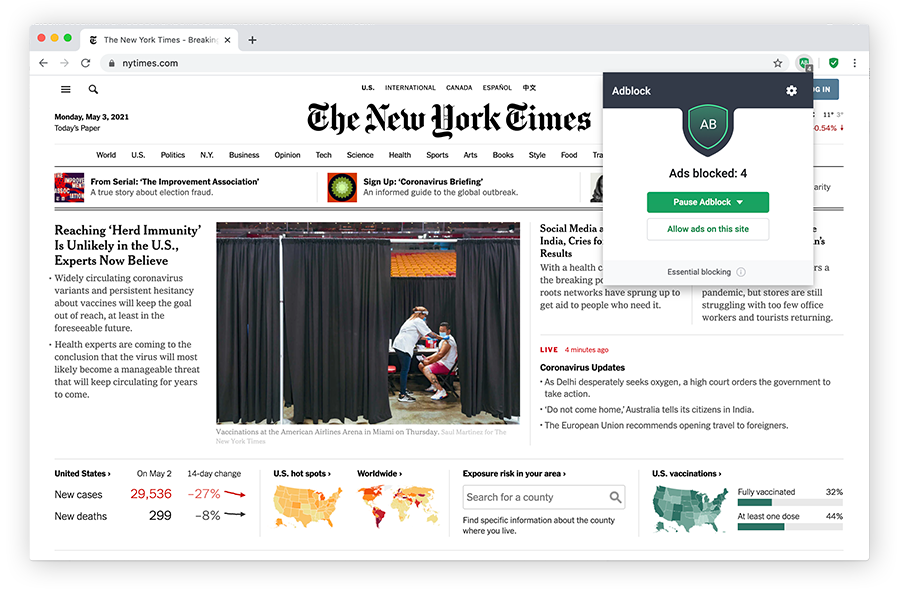
The free AVG Secure Browser can automatically block all ads. Or, you can set your preferences between Light, Basic, and Strict blocking. Plus, you can easily adjust all your privacy settings through one simple dashboard.
As cybersecurity threats become increasingly sophisticated, exploiting pop-ups and other web features, AVG Secure Browser — designed specifically with privacy and security at the forefront — will keep you safe. Get security and speed in one lightning-fast and buttery smooth browser.
Manage Pop-Ups Automatically
Download free AVG Secure Browser to easily manage pop-ups, block ads, and avoid web tracking.
Install free AVG Secure Browser to easily manage pop-ups, block ads, and avoid web tracking.
More helpful tips...
The latest privacy articles.
- A Guide to Tor Web Browser: Is It Safe?
- How to Fix the “Your Connection Is Not Private” Error
- How to Clear Your Search and Browser History
- How to Stop Pop-Up Ads from appearing on your Android Phone
- What Is Incognito Mode, Is It Safe, and Should You Use It?
- How to Set Your Default Browser on Any Device
- Private Browsing: What Is It and How to Use It on Any Browser
- How to Allow and Block Pop-Ups in Edge or IE on Windows 10
- What Is the about:blank Page?
- How to Disable Cookies in Your Browser
- What Are Internet Cookies?
- How to Clear Cache and Cookies on Your Browser
- Firefox Pop-Ups: How to Block and How to Allow Them
- The Best Browsers for Security and Privacy in 2024
- How to Block or Allow Pop-Ups in Chrome
- How to Remove Extensions (Add-ons) from Firefox
- How to Manage and Remove Chrome Extensions
- Best Chrome Extensions for Security and Privacy
- How to Speed Up Chrome, Firefox, and IE
- What Is Ad Tracking?
- Are Cookies Bad? Good vs. Bad Cookies
- 5 Quick Tips For a Safer Browsing Experience
- The Catch in the Cache: Why Cleaning Your Browser Makes It Safer
- Chrome Battery Life vs Edge, Firefox and Opera
- What Is a VPN and How Does It Work?
- Proxy, VPN, Tor: Differences and When You Should Use Them
- How to Unblock Websites & Access Restricted Content (13 Easy Ways)
- Geo-Blocking: What Is It and How to Bypass It
- What Is a Proxy Server and How Does It Work?
- VPN Kill Switch: What Is It and How Does It Work?
- How to Set Up a VPN on Mac
- The Best VPN Server Countries to Connect Through
- Should I use a VPN for gaming?
- What Is ISP Throttling? Why It Happens & How to Stop It
- Do I Need a VPN?
- How to Stop Endless Buffering Now
- How to Watch TV Shows and Episodes Online
- What Is Data Encryption and How Does it Work?
- How to Set Up a VPN on Windows
- How to Set Up and Use a VPN on iPhone or Android
- Smart DNS Proxy vs VPN. What’s the Difference? And Which Should You Choose?
- How to Find Your IP Address on Windows, Mac, iPhone, & Android
- Easy Ways to Change Your IP Address
- Static vs. dynamic IP addresses
- What Is an IP Address and How Does It Work?
- What Is TCP/IP?
- Private IP vs Public IP: What’s the Difference?
- What Is the Difference Between IPv4 and IPv6?
- Three Ways to Hide Your IP Address
- Signs Your Amazon Account Has Been Hacked
- Different Types of Hackers: White Hat, Black Hat, Gray Hat, and More
- How Are Computers Hacked and What Can You Do to Stop It?
- How to Tell If You’ve Been Hacked
- The Most Dangerous & Famous Hackers Today
- How to Tell If Your Email Has Been Hacked & How to Recover It
- Signs Your Phone Has Been Hacked
- What Is Router Hacking and How to Prevent It
- What Is Hacking? Everything You Need to Know
- The Nasty Truth of Data Breaches
- How to Prevent Your Car From Being Hacked
- How to Protect Your Private Documents With Sensitive Data Shield
- Equifax Hack: How to Protect Your Identity, Credit Cards, and More
- 3 Reasons to Never Use Fingerprint Locks on Phones
- Have You Ever Chatted With a Hacker Within a Virus?
- Thomson Data Breach Exposes Passenger Details
- What Is Two-Factor Authentication (2FA)?
- Password Ideas: How to Create a Strong Password
- How to Password Protect a File or Folder in Windows 10
- Password Cracking Techniques Hackers Use and How to Avoid Them
- How to Recover and Reset Your Lost Windows Password
- How to Choose the Best Password Manager
- How to Password Protect Excel Files, Word Docs, PowerPoints
- Why You Should Use a Password Manager
- What Is the Meaning of Clickbait and Is It Dangerous?
- How to Delete Your X (Formerly Twitter) Account
- How to Permanently Delete Your Snapchat Account
- How to Permanently Delete Instagram or Deactivate Your Account
- How to Delete or Deactivate Your TikTok Account
- How to See Sensitive Content on Twitter: A Step-by-Step Guide
- How to Deactivate or Delete Your Facebook Account
- Monkey Video Chat App: How Does It Work and Is It Safe?
- How to Stop Ads on Facebook
- What to Do If Your Instagram Account Is Hacked
- Facebook Leak: Check if Your Data is Part of The Breach
- Don't Let Your Old Social Media Accounts Come Back to Haunt You
- How to Stay Sane on Social Media in the COVID-19 Age
- Are You an Online Oversharer?
- Is Facebook Listening to Our Private Conversations?
- How to Stay Safe on Twitter: The Ultimate Guide
- Is It Safe to Sign in with Facebook or Google?
- Top Facebook Scams You Need to Know Aboutsignal_face
- No Caller ID: How to Find Out Who Called You
- How to Screen Record on Mac with Audio and Video: Step-by-Step Guide
- How to Completely Disappear From the Internet
- How to Turn Off Location Services on iPhone
- What Is CAPTCHA and How Does It Work?
- What Is a Digital Footprint and Why Does It Matter?
- Email Encryption: What Is It and How Do You Encrypt Emails?
- Is Coinbase Safe?
- What Is Cyberstalking and How to Protect Yourself from Online Stalkers
- SSL Certificates: What Are They and How Do They Work?
- Doxxing: What Is It and How to Prevent It
- The Most Secure Messaging Apps
- How to Hide Apps on Android
- App Permissions on Android & How to Control Them
- Dark Web Scans: When and Why to Use One
- How to Download Your Google Data with Google Takeout
- What Does Google Do With My Data... and Should I Be Worried?
- Data Brokers: Who They Are and How They Work
- Contact Tracing Apps and Their Privacy Concerns
- How to Hide Apps on an iPhone or iPad
- The Pros and Cons of Video Chat Apps
- Is Your Smartphone Tracking You?
- The Uses and Abuses of Facial Recognition
- The Privacy Implications of DNA Testing
- 5 Steps to Stop Robocalls: The Ultimate Guide to Beating the Bots
- A Day in Your Digital Life… and the Trail You Leave
- 4 Ways to Avoid Spam
- Stop Webcam Spying with Webcam Protection
- Spy Game: The Dangers of Webcam Hacking and How to Avoid Them
- Windows 10 Privacy: Everything You Need to Know to Keep Windows 10 from Spying on You
- The Truth Behind the Webcam Cover-Up
A Guide to Tor Web Browser: Is It Safe? A Guide to Tor Web Browser: Is It Safe?

How to Fix the “Your Connection Is Not Private” Error How to Fix the “Your Connection Is Not Private” Error

How to Clear Your Search and Browser History How to Clear Your Search and Browser History
You Might Also Like...

How to Stop Pop-Up Ads from appearing on your Android Phone How to Stop Pop-Up Ads from appearing on your Android Phone
Easily manage pop-ups with AVG Secure Browser
- Media Center
Home Products
- Free Antivirus Download
- Internet Security
- Android Antivirus
- Free Mac Antivirus
- Virus Scanning & Malware Removal
- Installation Files
- Beta Downloads
- Driver Updater
Customer Area
- Register Your License
- Anti-Theft Login
- Home Product Support
- Security & Performance Tips
- Online Research
Partners & Business
- Business Antivirus Software
- Partner Support
- Business Support
Privacy | Report vulnerability | Contact security | License agreements | Modern Slavery Statement | Cookies | Accessibility Statement | Do not sell my info | | All third party trademarks are the property of their respective owners.
We use cookies and similar technologies to recognize your repeat visits and preferences, to measure the effectiveness of campaigns, and improve our websites. For settings and more information about cookies, view our Cookie Policy . By clicking “I accept” on this banner or using our site, you consent to the use of cookies.
How-To Geek
How to allow pop-ups in safari on mac.
Sometimes you want browser pop-ups!
By default, Safari on Mac blocks pop-up windows from appearing. If you need to allow pop-ups for certain websites, it's easy to make the change in Safari Preferences. Here's how.
First, open Safari on your Mac and browse to the website that includes the pop-ups that you want to allow. In the menu bar, click "Safari," and select "Preferences" from the menu that appears.
In the preferences window of Safari 14 and up, click the "Websites" tab, and then scroll down to the bottom of the sidebar and select "Pop-up Windows."
In older versions of Safari, open Preferences and click the "Security" tab. Uncheck "Block pop-up windows" here. If you're still using an older version, we recommend updating Safari as soon as possible to keep your Mac safe .
With "Pop-Up Windows" selected, you'll see a box on the right titled "Allow pop-up windows on the websites below." Locate the name of the website that you want to allow pop-ups on in the list. (Remember that the site must currently be open in a Safari browser window.)
Click the drop-down box beside the website name and select "Allow."
Repeat this step with any other sites in the list that you want to allow pop-ups for.
If you want to allow pop-ups on all websites by default (although we strongly advise against it), click the drop-down menu beside "When visiting other websites" and select "Allow."
After that, close Safari Preferences, and your settings will be changed. The next time you visit the site that you allowed pop-ups for, the pop-ups will appear as expected. Happy browsing!
Related: Why You Should Update All Your Software
Change Websites settings in Safari on Mac
To change these settings, choose Safari > Settings, then click Websites.
The settings you can customize (such as Reader and Content Blockers) are listed on the left.
To apply a setting to a website on the right, first select the setting, then choose the option you want from the pop-menu next to the website.
Open Safari for me

How to delete cookies on an iPhone
M anaging cookies on your iPhone is essential for maintaining your privacy and managing your online browsing experience. Cookies are small files that websites use to track your online activity and preferences.
While they can be helpful for a smoother browsing experience, they can also raise privacy concerns. Whether you want to clear out your browsing history, remove unwanted cookies, or enhance your online privacy, this guide will walk you through the steps to deleting cookies on your iPhone.
By the end of this tutorial, you'll have a better grasp of how to keep your online data clean and your digital footprint more secure.
TO DELETE COOKIES ON AN IPHONE, YOU CAN FOLLOW THESE STEPS:
- Tap the 'Settings' app on your iPhone's home screen. It looks like a gear icon
- Scroll down in the Settings menu until you find the 'Safari' option. Tap on it to open Safari settings
- Under the Safari settings, scroll down until you see the 'Clear History and Website Data' option. Tap on it
- A pop-up window will appear asking you to confirm that you want to delete your browsing history, cookies, and other browsing data. Tap 'Clear History and Data' to proceed
- The iPhone will now clear your browsing history and cookies. This might take a few seconds.
- Once the process is complete, your cookies will be deleted, and you'll be taken back to the Safari settings screen.
- Your iPhone's cookies are now deleted
- Keep in mind that clearing your browsing history and website data will also remove your history and other browsing data, not just cookies.
- If you only want to delete cookies while keeping your browsing history intact, you might need to use a third-party browser that allows more granular control over data deletion.
- Please note that the exact steps and options may vary slightly depending on your iPhone's iOS version, so make sure you are following the instructions that match your iOS version.
Watch Live TV in English
Watch Live TV in Hindi


Acupuncture
Description.
This presentation will cover the concept of acupuncture, its various forms and diversities, the primary conditions it may address, the procedural steps involved, what happens during treatment, patient expectations during and after the session, safety considerations, and the contraindications associated with acupuncture.
After learning about what acupuncture is (in part 1 of the presentation), learners should expect to learn about how they can bring acupuncture into their practice and better understand some of the evidence for acupuncture.
- Additional Information
- Accreditation & Credit Statements
Dates and Times
End Date: 5/9/2027
As a result of this educational activity, webcast participants will be able to:
- To identify the primary conditions that acupuncture may address.
- To understand the contraindications associated with acupuncture
- Present evidence for acupuncture for common conditions.
- Discuss when to consider acupuncture and how to find an acupuncturist for your patient.
Webcasts Files
Webcasts links.
- Dr. Linda Chun, MD
- Dr. Shengyi Mao, MD
- Dr. David Wang, MD
Accreditation Statement
The Ohio State University is accredited by the Accreditation Council for Continuing Medical Education (ACCME®) to provide continuing medical education for physicians.
AMA Credit Designation Statement
The Ohio State University designates this enduring material for a maximum of 1.00 AMA PRA Category 1 Credit (s) ™ . Physicians should only claim credit commensurate with the extent of their participation in the activity.
Maintenance of Certification
Successful completion of this CME activity, which includes participation in the evaluation component, enables the participant to earn up to 1.00 MOC points in the American Board of Internal Medicine’s (ABIM) Maintenance of Certification (MOC) program. Participants will earn MOC points equivalent to the amount of CME credits claimed for the activity. It is the CME activity provider’s responsibility to submit participant completion information to ACCME® for the purpose of granting ABIM MOC credit.
Recognition Statement

Successful completion of this CME activity, which includes participation in the evaluation component, enables the learner to earn credit toward the CME of the American Board of Surgery’s Continuous Certification program. It is the CME activity provider's responsibility to submit learner completion information to ACCME for the purpose of granting ABS credit.
Technical playback requirements for viewing webcasts:
We recommend that viewers have at least a 1 Mbps Internet Download Speed to view our webcasts. More details on requirements are listed below.
Special Note: Pop-up Blocker must be turned off to view our webcasts.
View tutorial on Turning Off Pop-up Blocker to View Webcasts .
Required Internet Download Speed for viewing webcasts is a minimum of 1 Mbps.
Check your Internet Speed here - www.speedtest.net
Below is a list of support computers and devices that will play our MedNet21 Webcasts:
Microsoft Windows Windows 10, Windows 8, Windows 2008 R2, Windows 2008, or Windows 7
- Firefox®, Google Chrome™, Microsoft Edge, or Internet Explorer® 8.0 and higher
- Broadband Internet or Wi-Fi connection
Mac Apple Mac OS X 10.10 and higher
- Apple Safari® 6, Firefox, or Chrome
iPad iPad, iPhone, iPod (iOS 10 and above) - Supported devices: iPad Pro, iPad (5th generation), iPad Air 2, iPad Air, iPad (4th generation), iPad mini 4, iPad mini 3, iPad mini 2
- Apple iOS 10.0 and higher
- Apple Mobile Safari™
- Wi-Fi or cellular data (3G or higher) connection
iPhone and iPod iPhone 5 and higher - Supported devices: iPhone 7, iPhone 7 Plus, iPhone 6s, iPhone 6s Plus, iPhone 6, iPhone 6 Plus, iPhone SE, iPhone 5s, iPhone 5c, iPhone 5, iPod Touch (6th generation)
- Apple Mobile Safari
- Mediasite Mobile App (iOS 10.0)*
Microsoft Surface and Windows RT Tablets Windows 8, 8.1, or 10
- Microsoft Edge or Internet Explorer 10.0 and higher*
- Wi-Fi connection
Android™ Tablets and Mobile Devices Android 4.4 and higher
- Chrome browser
Linux® (on-demand) OpenSUSE ® 11.0 or Ubuntu ® with the following:
- FFmpeg plugin
- Chromium web browser
Note: Listen to Audio Only CME Podcasts of MedNet21 by visiting the page for the webcast & clicking the Files tab.
Support contact information: If you need any assistance with viewing webcasts or listening to Podcasts, please contact Derrick Freeman via e-mail at [email protected] or by phone at 614.293.3473 .
Need help with this Webcast?
Please contact the Webcast coordinator listed below:
Derrick Freeman Department: Center for Continuing Medical Education Phone: (614) 293-3473 Email: [email protected]

IMAGES
VIDEO
COMMENTS
On your iPhone or iPad, go to Settings > Safari. Turn on Block Pop-ups. Turn on Fraudulent Website Warning. On your Mac, open Safari and choose Safari > Settings (or Preferences) from the menu bar. In the Websites tab, you can configure options to allow or block some or all pop-ups. In the Security tab, turn on the setting to warn when visiting ...
Allow pop-ups in Preferences. Open Safari and click Safari > Preferences from the menu bar. Select the Websites tab. On the left, scroll down to and pick Pop-Up Windows. To the right, you have your Currently Open Websites at the top with any Configured Websites at the bottom. Next to each, select the drop-down box and pick Allow for those you ...
To allow sites to open pop-up windows in your Safari browser, open the Settings app on your iPhone. In Settings, scroll down and select "Safari." On the "Safari" page, scroll down and toggle off "Block Pop-Ups." To turn on Safari's pop-up blocker in the future, re-enable the "Block Pop-Ups" option.
Open Settings. Scroll down to Safari and tap it. Scroll down under General until you find Block Pop-ups. If the toggle is green, tap the Block Pop-ups toggle to turn off the pop-up blocker on Safari. That's how to disable the pop-up blocker on iPhone. For one of Apple's simpler settings, it can make quite a difference in your experience while ...
Open Settings. Scroll down and select Safari . Under General, you'll find the toggle switch for Block Pop-ups. Use it to enable or disable pop-up blocking. Go back to Safari and reload the website that requested pop-up access. It should now be able to open a new pop-up window in Safari and display the content.
To disable Safari's pop-up blocker on your iPhone or iPad, first, open the Settings app on your phone. Settings is where many of Safari's options are located. On the Settings page, scroll down and tap "Safari." On the "Safari" page that opens, you have various options to configure for your web browser. Here, at the bottom of the "General ...
Step 3: Toggle Off the Block Pop-ups Option. Find the Block Pop-ups option and switch the toggle to the off position. By default, Safari blocks pop-ups to provide a smoother browsing experience. However, toggling this off will allow pop-ups to show up on your browser. After completing these steps, pop-ups will be allowed on websites when using ...
How to block pop-ups on Safari for iOS and iPadOS. 1. Open the Settings app, then scroll down and tap Safari. (Image credit: Future) 2. Toggle on Block Pop-ups. (Image credit: Future) That's ...
Step 1: Open Safari on your Mac. Step 2: Visit a website. If you see Safari blocking a pop-up, right-click (or two-finger click on the Mac trackpad) on the address bar at the top. Step 3: Open the ...
Click on the Websites tab at the top of the Preferences window. From the left side-bar, click on Pop-up Windows. Finally, click the drop-down menu in the bottom right corner of the window and select Allow. This will cause Safari to allow all pop-ups. You can also choose to block all pop-ups or notify you every time they are blocked as well.
Lastly, you can set up Safari Preferences to enable pop-ups in the browser. Here's how to do it: Simply click Safari in the menu bar and select Preferences or Settings (based on your macOS version) Safari > Settings. Next, go to the Websites tab, scroll down, and select Pop-Up Windows.
To allow pop-ups on your iPhone running iOS 17, simply head to the Settings app, select Safari, and toggle off the 'Block Pop-ups' option. By following these steps, you'll soon be able to access all the pop-up content your heart desires. After completing this action, any website you visit using Safari will be able to display pop-up windows.
These steps work exactly the same for both the iPhone and iPad. Go to Settings > Safari . In the General section, tap the Block Pop-ups toggle. It will turn white to indicate it's turned off. Launch the Safari app. The changes will take place immediately, and you should be able to see pop-ups on websites that use them.
From the home screen, open Settings . Scroll down the list and tap Safari . In the Safari screen, locate the General section. Tap the Block Pop-ups toggle switch to turn it on or off. It turns green to indicate that Safari is blocking pop-ups. Another way to enable or disable the pop-up blocker in Safari is to select Preferences > Security ...
This setting is crucial for controlling the behavior of pop-up windows while you browse on Safari. Toggle the Pop-Up Blocker: Upon locating the pop-up setting, you'll likely encounter a toggle switch that enables or disables the pop-up blocker. To allow pop-ups to appear on Safari, simply toggle the switch to the "On" or "Allow" position.
Visit the website for which you want to allow pop-ups in Safari. Control -click on the URL in the address bar and choose Settings for [Website URL] from the context menu. Then, click the dropdown next to Pop-up Windows and choose Allow . From now on, Safari will allow pop-up windows on the specific website.
Step 4: Toggle off 'Block Pop-ups'. Tap the toggle switch next to 'Block Pop-ups' to turn it off. The switch will turn from green to gray, indicating that the pop-up blocker is now disabled. After completing these steps, your iPhone will now allow pop-up windows when you're browsing with Safari. This means that any site that needs to ...
HI BBguntz, Try closing Safari and then restarting your device and then try Safari again. Close an app 1. On an iPhone or an iPad with no home button from the Home screen, swipe up from the bottom of the screen and pause slightly in the middle of the screen 2. On an iDevice with a home button, double-click the Home button and swipe right or left to find the app that you want to close 3.
In the settings window, select Block from the drop-down menu next to Pop-up Windows. Safari will now block pop-up messages on that site, but your Mac will continue to allow pop-ups from other websites. How to block Safari pop-ups on iPhone and iPad. Pop-ups also affect mobile devices, but fortunately Safari has a pop-up blocker for iPhone and ...
9. Yes, with Safari Version 12 or higher, you can allow popups for a specific website. Here are step-by-step instructions: Right click on the URL (when you're NOT in a text entry mode) Select "Settings for This Website..." Select "Allow" under "Pop-up Windows". Share.
Here's how. First, open Safari on your Mac and browse to the website that includes the pop-ups that you want to allow. In the menu bar, click "Safari," and select "Preferences" from the menu that appears. In the preferences window of Safari 14 and up, click the "Websites" tab, and then scroll down to the bottom of the sidebar and select "Pop-up ...
Pop-up Windows. Block pop-up windows that appear when you visit a website. Block and Notify: When you visit the site, Safari displays an icon in the Smart Search field. You can click the icon to display the pop-up windows. Block: The site can't display pop-up windows. Allow: The site can display pop-up windows.
A pop-up window will appear asking you to confirm that you want to delete your browsing history, cookies, and other browsing data. Tap 'Clear History and Data' to proceed The iPhone will now clear ...
View tutorial on Turning Off Pop-up Blocker to View Webcasts. ... www.speedtest.net. Below is a list of support computers and devices that will play our MedNet21 Webcasts: Microsoft Windows Windows 10, Windows 8, Windows 2008 R2, Windows 2008, or Windows 7 ... Apple Safari® 6, Firefox, or Chrome; Broadband Internet or Wi-Fi connection;